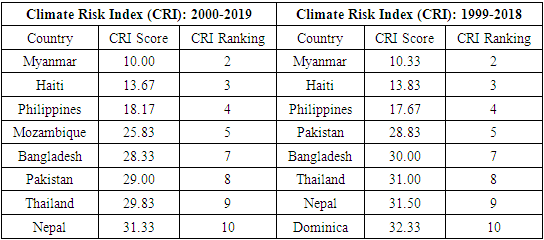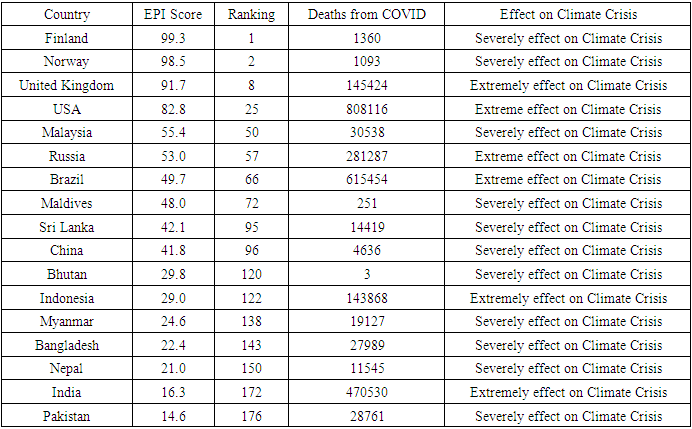-
Paper Information
- Paper Submission
-
Journal Information
- About This Journal
- Editorial Board
- Current Issue
- Archive
- Author Guidelines
- Contact Us
World Environment
p-ISSN: 2163-1573 e-ISSN: 2163-1581
2021; 11(2): 41-82
doi:10.5923/j.env.20211102.01
Received: Oct. 28, 2021; Accepted: Nov. 24, 2021; Published: Dec. 15, 2021

Unexpected Effects of Advanced Wireless Sensor Technology on Climate Change
Md Rahimullah Miah 1, 2, Md Mehedi Hasan 3, Jorin Tasnim Parisa 4, Md Sher-E-Alam 5, Foujia Akhtar 6, Motia Begum 7, Chowdhury Shadman Shahriar 8, Alexander Kiew Sayok 2, Fuad Abdullah 9, Mir Abu Saleh Shamsuddin 10, Md Shoaibur Rahman 11, Md. Amir Sharif 12, AAM Shazzadur Rahman 13, Mohammad Shamsul Alam 14, Mohammad Belal Uddin 15, Shahriar Hussain Chowdhury 16
1Department of IT in Health, North East Medical College and Hospital, Affiliated with Sylhet Medical University, Sylhet, Bangladesh. and PhD Awardee from the IBEC, UNIMAS, Sarawak, Malaysia
2Research Fellow, IBEC, Universiti Malaysia Sarawak (UNIMAS), Kota Samarahan, Sarawak, Malaysia
3Department of Law, Green University of Bangladesh, Dhaka, Bangladesh
4Government S.C. Girls’ High School, Sunamganj Sadar, Sunamganj, Bangladesh
5Department of Law and Justice, Metropolitan University, Sylhet, Bangladesh
6Department of Economics, Moulvibazar Government Women’s College, Moulvibazar, Bangladesh
7Lawyer, Judge’s Court, Sylhet and Sunamganj, Bangladesh
8USMLE Student, USA and Ex-student of North East Medical College, Sylhet, Bangladesh
9Faculty of Science, Memorial University of Newfoundland, Canada
10Chittagong Government Teachers’ Training College, Bakolia, Chittagong, Bangladesh
11Department of Agroforestry and Environment, Hajee Mohammad Danesh Science & Technology University, Dinajpur, Bangladesh
12Department of Accounting and Information Systems, Begum Rokeya University, Rangpur, Bangladesh
13Department of Medicine, North East Medical College and Hospital, Affiliated with Sylhet Medical University, Sylhet, Bangladesh
14Department of Forensic Medicine, North East Medical College and Hospital, Affiliated with Sylhet Medical University, Sylhet, Bangladesh
15Department of Forestry and Environmental Science, Shahjalal University of Science and Technology, Bangladesh
16Department of Dermatology, North East Medical College and Hospital, Affiliated with Sylhet Medical University, Sylhet, Bangladesh
Correspondence to: Md Rahimullah Miah , Department of IT in Health, North East Medical College and Hospital, Affiliated with Sylhet Medical University, Sylhet, Bangladesh. and PhD Awardee from the IBEC, UNIMAS, Sarawak, Malaysia.
| Email: |  |
Copyright © 2021 The Author(s). Published by Scientific & Academic Publishing.
This work is licensed under the Creative Commons Attribution International License (CC BY).
http://creativecommons.org/licenses/by/4.0/

At the heart of today's intensifying global climate crisis is the misuse of wireless sensor technology. A class of humanoid climate criminals is responsible for this unwanted climate change. Everyone is using advanced wireless technology, but no one is fully aware of its impact on climate change. Sophisticated sensor technology has given people mobility, while also embracing psychological disorders associated with the stagnation of life. That is why some people strive for success, while others are frustrated by its misuse. Many scientists, researchers, experts, policy makers, lawyers, and statesmen around the world are worried, surprised, and stunned by unpredictable climate change. Experts are all looking for the right way to live well, mitigating the climate crisis for present and future generations. That is why climate scientists have identified the root causes of climate change through wireless tracking with processed sensor networks at the locations in Global Positioning System and Global Navigation Satellite Systems. Research shows that cyber hackers are abusing wireless sensor technology to cause climate change around the world. The study represents artificial technological disasters, resulting in sensor cyclones and hurricanes, wildfires, flash floods, non-seasonal floods, sensor landslide, artificial earthquakes, sensor tsunamis, bridge collapses, river erosion, sensor damage to buildings, plants, people, and animals. It is also known that frequent illness, sudden cracking in roads and highways, burning objects, sudden temperature fluctuations, swelling and shrinking of water, drought, desertification, digital poisoning and object obstructing etc. occurred by misuse of processed wireless sensor technology that can kill living people and animals in a specific and dynamic place in an instant. The researchers believe that the novel climate study will open the eyes of all conscious circles and they will be able to understand the root causes of global climate change and make the right decision for the rationalized generations who are facing the complicated challenges of an increasingly unstable future accordingly. Finally, the study suggests the path for future research into a new alternative dynamic policy for preventing climate disasters for a peaceful world that will protect all humans and living-beings on Earth and ensure the right to life for all.
Keywords: Climate crisis, Wireless technology, GPS, GNSS, Psychological disorders, Policy
Cite this paper: Md Rahimullah Miah , Md Mehedi Hasan , Jorin Tasnim Parisa , Md Sher-E-Alam , Foujia Akhtar , Motia Begum , Chowdhury Shadman Shahriar , Alexander Kiew Sayok , Fuad Abdullah , Mir Abu Saleh Shamsuddin , Md Shoaibur Rahman , Md. Amir Sharif , AAM Shazzadur Rahman , Mohammad Shamsul Alam , Mohammad Belal Uddin , Shahriar Hussain Chowdhury , Unexpected Effects of Advanced Wireless Sensor Technology on Climate Change, World Environment, Vol. 11 No. 2, 2021, pp. 41-82. doi: 10.5923/j.env.20211102.01.
Article Outline
1. Introduction
- Climate change has provided insights into the responses of the Earth's systems to external electromagnetic and gravitational forces [1,23]. The world and its population are facing an existential threat due to the increasing misuse of advanced sensor technology, the lack of poverty and hunger eradication, and the adverse effects of environmental pollution and climate change [19]. The world's population is growing in contact with heat due to climate change. Between 2000 and 2016, the number of people exposed to heatwaves increased by about 125 million [20]. Heatwaves are the most dangerous of the natural disasters, which killed more than 166,000 people worldwide between 1998 and 2017 [21]. Rising temperatures, unpredictable wildfires, and cyclones have already exacerbated the weather and climate conditions in every region of the world [39]. So, the whole world watched from the World Climate Conference (COP-26) in Glasgow, UK - many are optimistic about finding the right solution. One of the goals of the conference is to take steps to keep the issue of temperature rise within reach with the cooperation of all. The world commented that this meeting was the last chance to deal with global warming. Researchers believe that a 'big change' will come through this conference. But will that be possible in reality? Because world leaders are responsible for the world's climate change. So, all conscious people have to come forward to keep all kinds of pressure on them. The COP-26 climate conference is going to be held in Scotland from October 31 to November 12, 2021. This is the largest climate conference since the 2015 meeting in Paris. The talks are seen as an important step in determining the rate of global carbon emissions to slow global warming. Everyone is hoping that there is an opportunity for change through international conferences like COP-26. Because, in these, many people will come together and take initiative in making a good decision. Consequently, we all need to make sure that we are using the opportunities we have to make a real difference, that we are applying them properly. Who is responsible for the world's climate change? What is the right way to solve the current problem? The Glasgow conference will try to reach a consensus among the major economies on how to reduce their carbon emissions. Grants will also be sought from rich countries to help poor countries cope with the effects of climate change. From this conference, everyone is hopeful that if we want to save the planet in the true sense of the word, we have to move away from the tendency to create loopholes and focus on the main place. A wonderful view of the beautiful world, surrounded by green forests, and wandering in aesthetic values, gives a touch of joy. But what is happening today - the lungs of the world - in the Amazon forest with the fire of sensor technology and fire in the water to damage fishes. They are the stigmatized cyber hackers of the world. Is that so? Burning forests in Indonesia, Malaysia, Australia, the Philippines and Vietnam - more names are on fire. Thus, the end of thousands of biodiversity, we observe an enhanced climate crisis. There is a young generation in the misuse of sensor technology. What was the crime of the world's forests? And who is committing the crime? The answer to the question several times responds in ISNAPHOCE (Impact of Sensor Networks towards Animals, Plants, Human beings, Objects, Climate change and Environmental issues) research. Cyber hackers are doing this illegal work through telematics devices invisible to everyone around the world. Everyone is standing like a silent witness - administration and the policy makers are sleeping like coronaviruses with the oil of technology in their noses. What will they do? Their hands are obstacles in the shackles of information technology, obstacles are their thoughts and consciousness, whose heads are bald. They are still unconscious, standing in the evening of life - not even a little conscious of the attack of the coronavirus. Now is the time to wake up, to protect the earth's environment, to be safe, to have the next generation.The climate is constantly changing abnormally. Seeing this change, different people of the world are giving different opinions, again different programs are going on to make people aware, it is being published in the media, after research it is being published in different journals. Climate summits are being held in different countries to solve the climate crisis, a lot of money is being spent or wasted. But there is no solution to the climate crisis. Rather, the climate crisis is slowly turning into a major crisis. No one can find the root cause of climate change. However, the political leaders are talking about resolving the climate crisis in a huge budget keeping the main secret secret. According to some climate researchers, at the root of the current climate crisis lies the misuse of advanced wireless sensor technology, which has been identified from various experiments. The pilot test was ISNA (Impact of Sensor Network on Animals) and the final test was ISNAPHOCE (Impact on Sensor Network towards Animals, Plants, Humans, Objects, Climate and Environment), a research work on PhD research conducted at UNIMAS, Sarawak, Malaysia. From 8th October 2014 to 21st May 2018. After that seminars, conferences, academic discussions, awareness programs are conducted in different organizations and it is spread through daily newspapers and social media. At that time a group of cyber hackers spread false propaganda and spread confusion among the people and tried to stop it by creating suspicion in my research. Then people believed in cyber hackers and got me wrong. If the people of the world had believed and been aware of my research, the effects of today's climate crisis would not have been felt in the world.The study aims to find out the effects of innovative wireless sensor technology is the causes of global climate crisis due to lack of update policy identifying the core challenges to prevent climatic catastrophe with capable recommendations to save the living beings.
2. Materials and Methods
- The study followed the materials and methods from the URL [1,2,3,4,5,9]:a. URL: http://article.sapub.org/10.5923.j.geo.20211101.02.html [1]b. URL: http://article.sapub.org/10.5923.j.bioinformatics.20211101.01.html [3] c. URL: http://article.sapub.org/10.5923.j.scit.20211101.02.html [8]d. URL: http://article.sapub.org/10.5923.j.ajbe.20201001.03.html [2]e. URL: http://article.sapub.org/10.5923.j.fs.20211101.01.html [4]f. URL: http://article.sapub.org/10.5923.j.ijas.20211102.02.html [9]
2.1. Study Site
- The study site of this research was conducted at the Universiti Malaysia Sarawak (UNIMAS), Sarawak, Malaysia from October 8, 2014 to May 21, 2018 as a part of PhD degree. The study follows the different parameters on sample size and ISNAPHOCE (Impact of Sensor Networks towards Animals, Plants, Human beings, Objects, Climate change and Environmental Issues) data size and design, tracking procedure, primary and secondary data collection, data compilation and analysis related to the undesirable climate crisis due to misuse the advanced wireless sensor technology worldwide.
2.2. Data Size and Design
- The research presented in different parameters including 7 cats and 7 dogs individually, plant species, separate room, cartoon bus, ice block and old object with the design of ISNAPHOCE experiment. The study followed the tracking system towards animals, plants and objects to identify the effect of the processed wireless sensor networks towards them separately.
2.3. ISNAPHOCE Procedures
- Primary and secondary climate data collection procedures are diverse. The study identified the unexpected effects of advanced wireless sensor technology on climate change with GPS locations and GNSS positions according to research objectives from ISNAPHOCE procedure. The steps of this procedure illustrated in Figure 1.
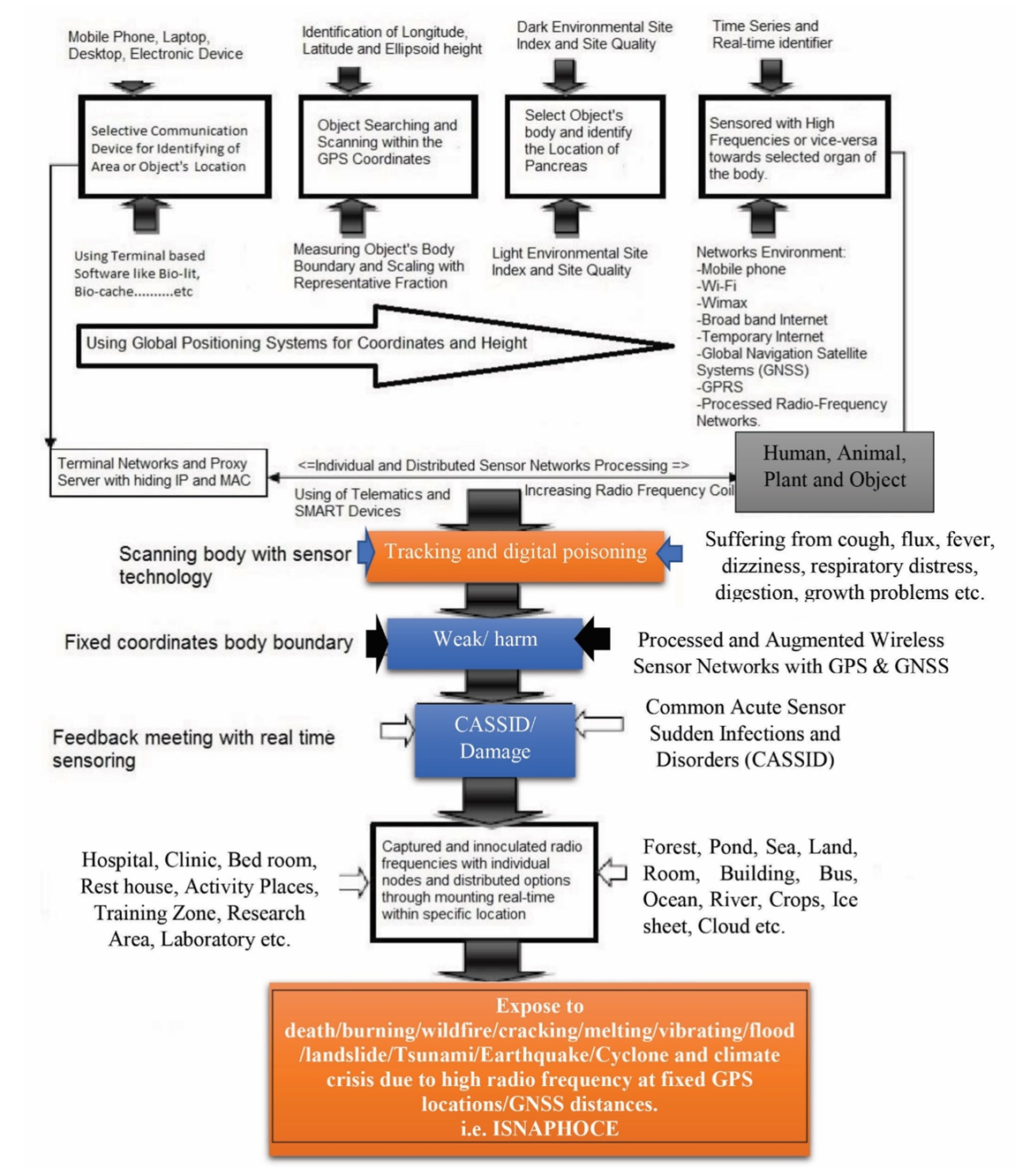 | Figure 1. ISNAPHOCE steps [9,13] |
2.4. Diverse Tracking Process
- The diverse tracking procedures include in different stages with ISNAPHOCE experiment from built-in sensor device, particularly identification of fixed GPS locations including longitude, latitude and ellipsoid height, which as shown in Figure 2. The wireless sensor tracking systems included at a fixed GPS location and GNSS distances of animals, plants and objects in required stages. The processed wireless sensor networks tracked animals, plants, and objects in different GPS and GNSS locations including (i) ellipsoid height, (ii) longitudinal distance, and (iii) adjacent latitude. The tracking parameter included (a) open active eyes cats, (b) tightly closed eyes dogs, (c) bus, (d) ice blocks, (e) huts, (f) tree, (g) brick wall, (h) water with covering kettle, (i) football, and (j) stone. The ice block was 3'2" length, 1'2" wide, 8" thickness and 40 kg in weight.
2.5. Climate Data Compilation and Analysis
- All quantitative and qualitative related climate data collected and compiled according to research objectives. These compiled data checked for accuracy from diverse sources are also verified for the preparation of master sheet for analysis and interpretation using update software like MS Office 2019, R ver. 3.6 and SPSS ver.27.
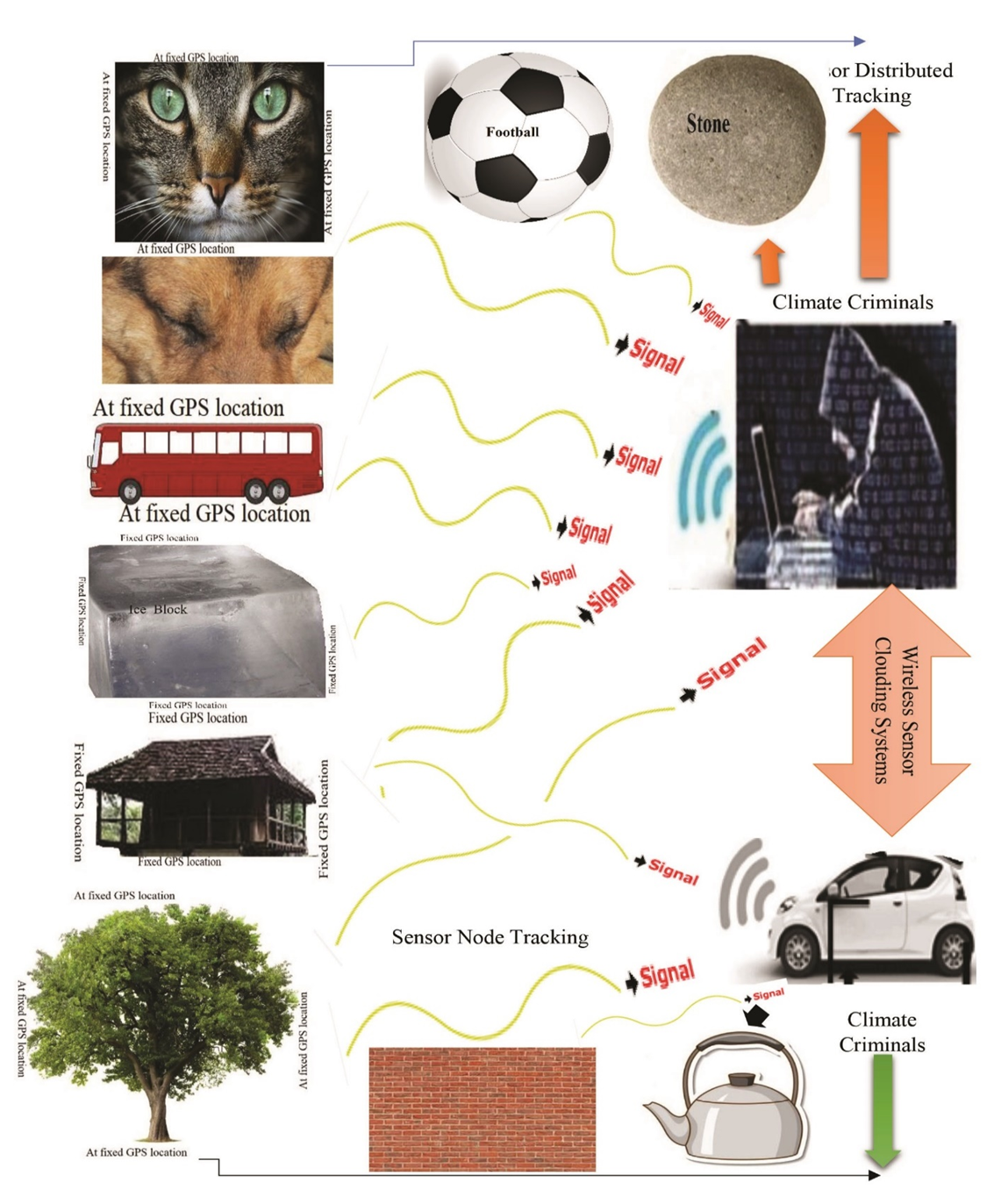 | Figure 2. Wireless Sensor Networks Tracking towards animals, plants and objects at fixed GPS locations |
3. Results
3.1. Indications of Sensor Climate Crisis
- From the study on ISNAPHOCE experiment, the findings of tracking illustrated in different ways, such as burning, melting, blocking, tracing, felling and clouding which included with climate crisis and environmental issues due the processed wireless sensor tracking at a fixed GPS locations. The identified parameters at a fixed GPS location tracking, the following characteristics identified, such as:(i) Sensor Cracking(ii) Burning(iii) Melting(iv) Busting(v) Blocking(vi) Tracing(vii) Falling(viii) Felling(ix) Cloating(x) Clouding(xi) Floating(xii) Increasing temperature(xiii) Decreasing temperature(xiv) Capturing(xv) Swelling(xvi) Shrinkage(xvii) Oscillating(xviii) Vibrating(xix) Fluctuating(xx) Fructuring(xxi) Undulating(xxii) Horrible sound and noising(xxiii) Sweating(xxiv) Sensor vomiting(xxv) Sensor sneezing(xxvi) Sensor collapsing(xxvii) Digital killing
3.2. Sensor Cracking
- The study showed that the brick wall and stone cracked at a fixed GPS location due to processed wireless sensor technology, which as shown in Figure 3 and Figure 4.
 | Figure 3. Brick wall cracked due to processed wireless sensor tracking |
 | Figure 4. Big stone cracked due to processed wireless sensor tracking |
3.3. Sensor Blocking
- The results show that the water pipe, gasoline and other objects blocked at a fixed GPS location due to processed wireless sensor technology, which as shown in Figure 5.
 | Figure 5. Sensor blocked due to processed wireless sensor tracking |
3.4. Sensor Collapsing
- The results show that the bridge, building and other objects collapsed at a fixed GPS location due to processed wireless sensor technology, which as shown in Figure 6.
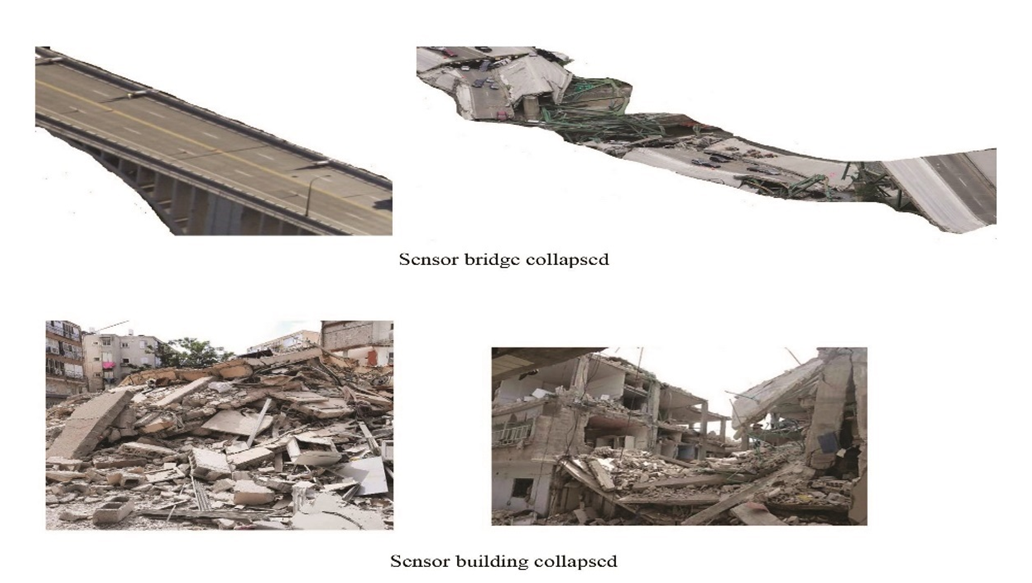 | Figure 6. Sensor collapsed due to processed wireless sensor tracking |
3.5. Sensor Wildfire
- The study showed that the plant species and forest zone burnt at a fixed GPS location due to processed wireless sensor technology, which as shown in Figure 7. This is a sensor wildfire.
 | Figure 7. Plant species burnt due to processed wireless sensor tracking |
3.6. Sensor Object Burning
- The study showed that the bus, vehicle, building and other objects burnt at a fixed GPS location due to processed wireless sensor technology, which as shown in Figure 8 and Figure 9. The results reflect on the other objects burnt with the processed wireless sensor tracking.
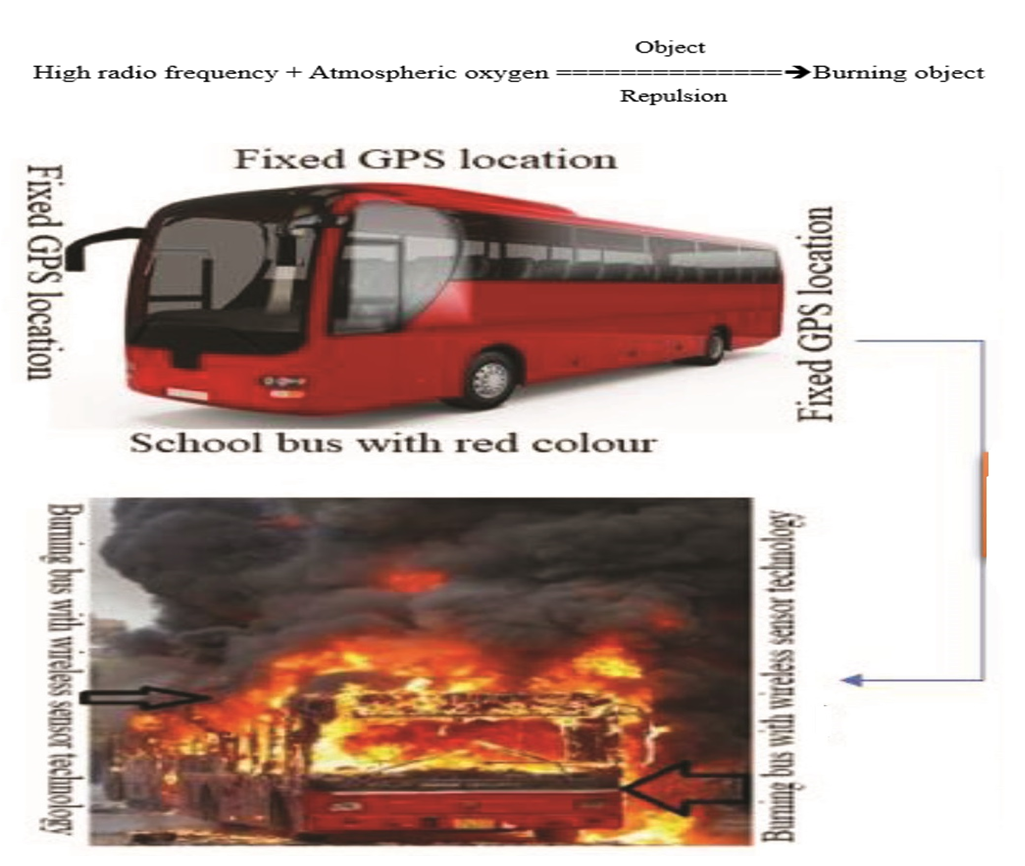 | Figure 8. Bus burnt due to processed wireless sensor tracking |
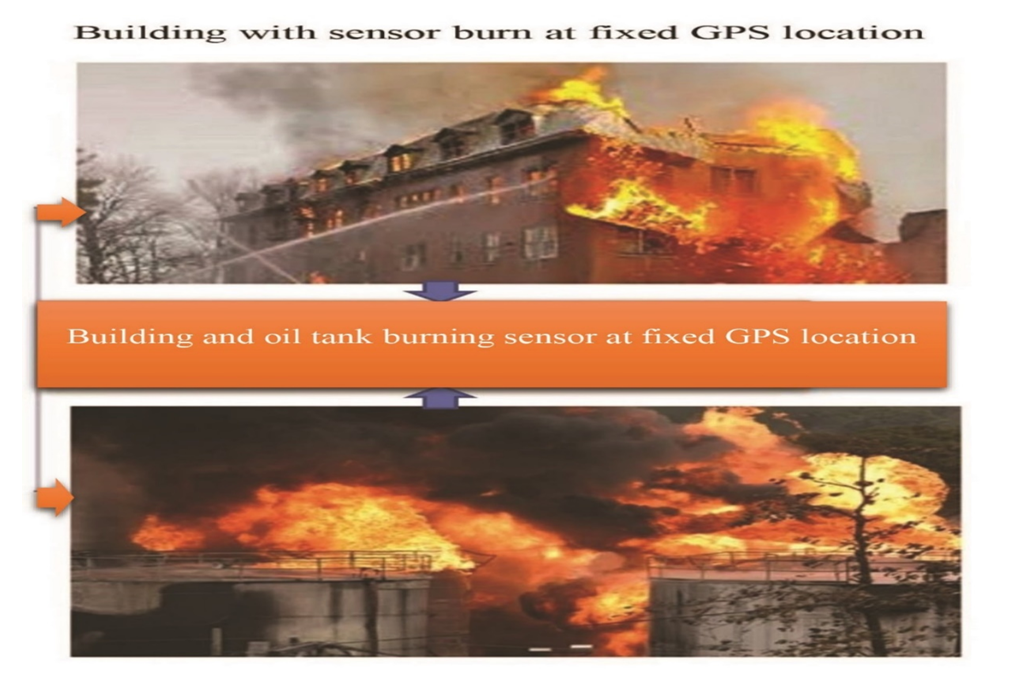 | Figure 9. Building and oil tank burnt due to processed wireless sensor tracking |
3.7. Sensor Melting
- The study showed that the collected ice block melted at a fixed GPS location due to processed wireless sensor technology, which as shown in Figure 10.
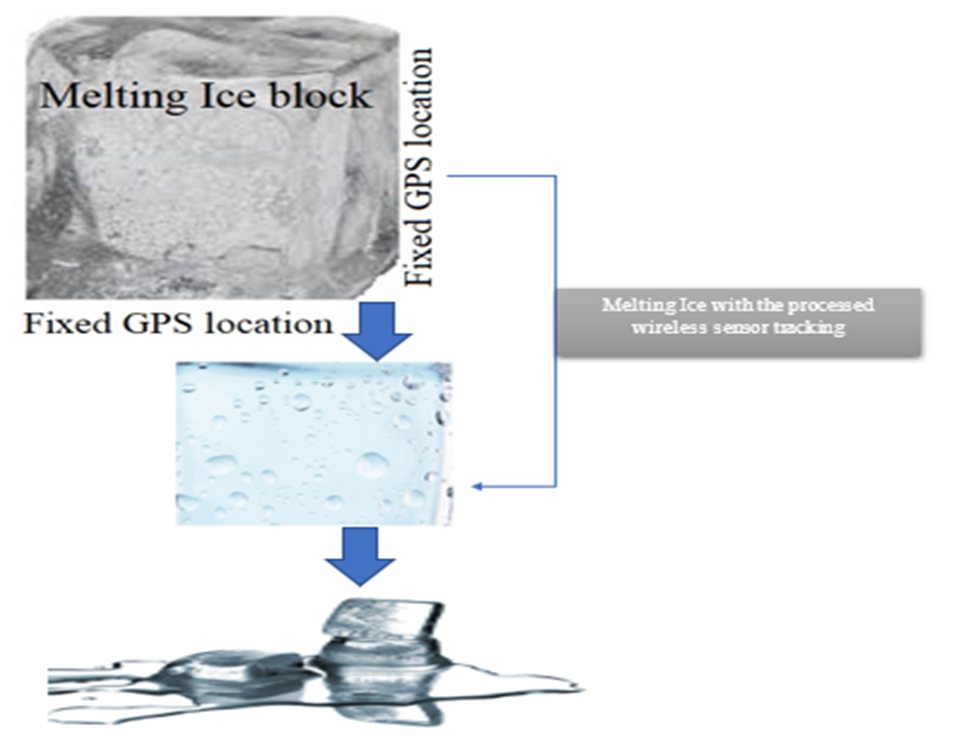 | Figure 10. Melting ice block with the processed wireless sensor tracking |
3.8. Sensor Tracking and Climate Change
- The study showed that different objects affected a fixed GPS location due to processed wireless sensor technology, which as shown in Figure 11. Stone, road and other objects cracked due to sensor tracking, which compares with the Ice sheet at GreenLand and Arctic zone. The findings reflect on climate change, particularly flash flood, non-seasonal flood, drought, desertification etc.
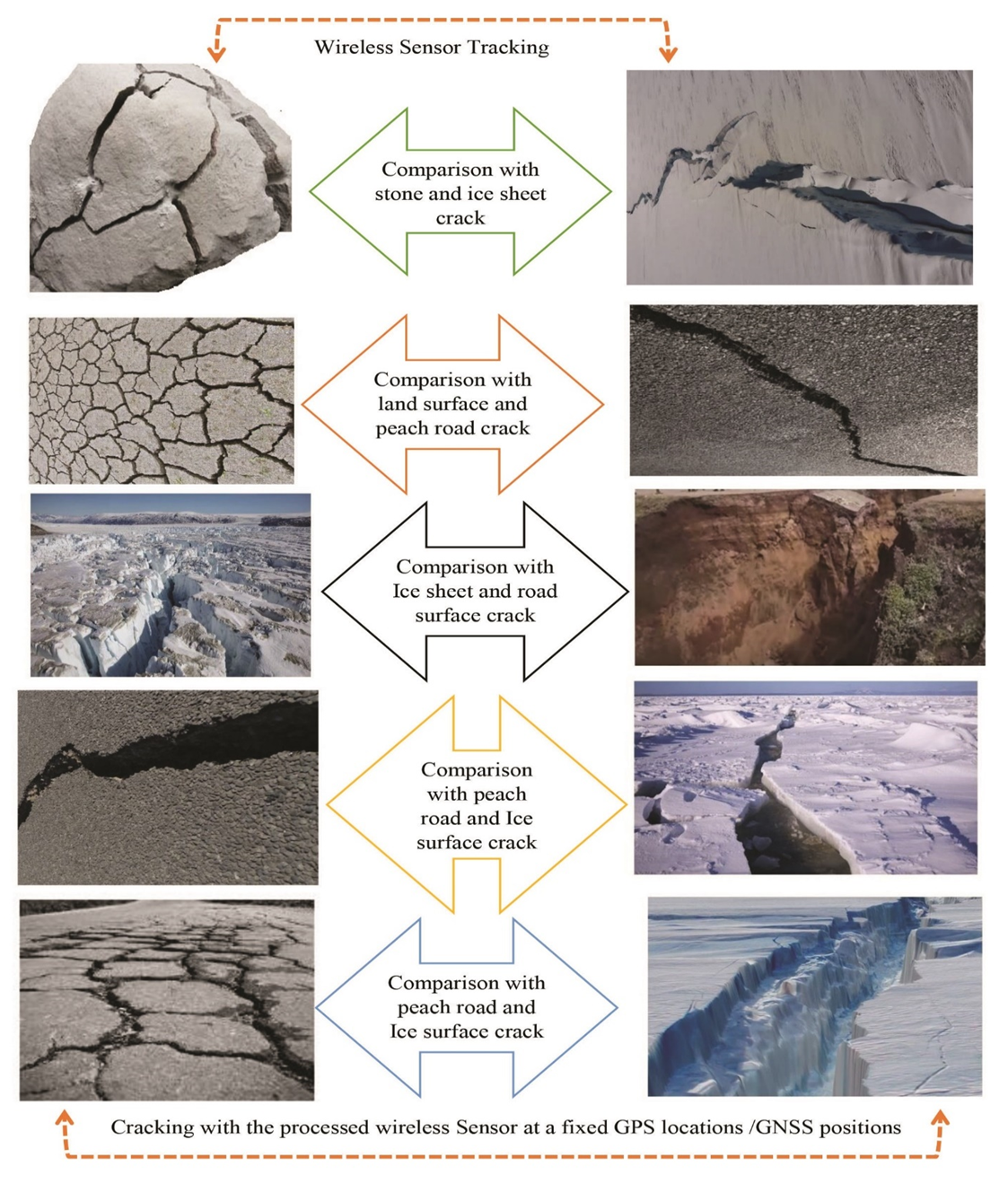 | Figure 11. Different object affects with the processed wireless sensor tracking |
3.9. Comparative Study on Melting Ice and Melting Cloud Particles
- The study showed that ice and cloud objects are melting at a fixed GPS location and GNSS position due to processed wireless sensor technology, which as shown in Figure 12. The findings reflect on climate change. The study represents rainfall and precipitation also occurred on the earth surface due to advanced wireless sensor technology.
 | Figure 12. Melting ice block and cloud particles with the processed wireless sensor tracking |
3.10. Clouding Satellite System on Precipitation
- The study showed that cloud particles melted due to the processed wireless sensor tracking embedded with clouding satellite systems and rains fall on the earth surface, which as shown in Figure 13.
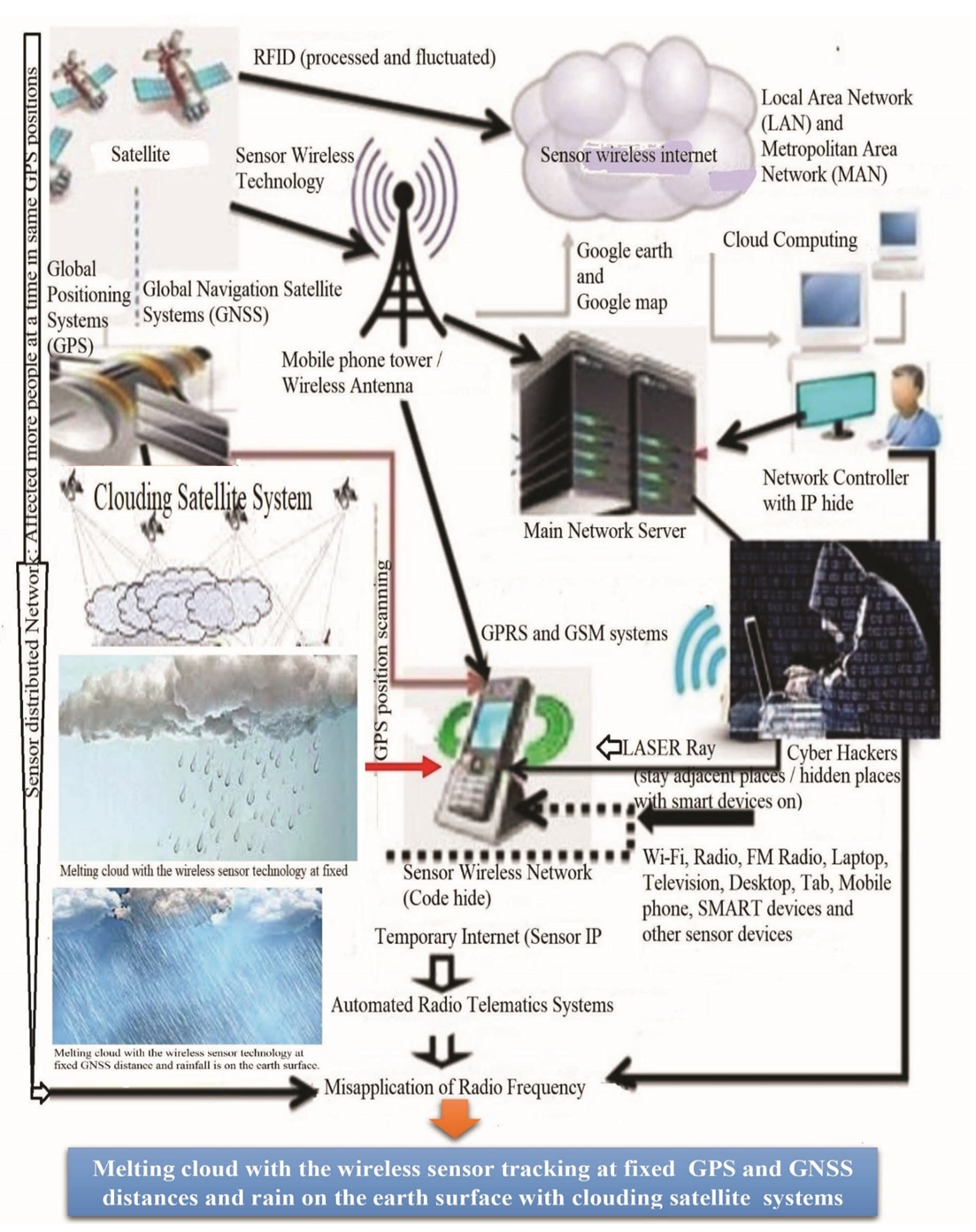 | Figure 13. Melting cloud with wireless sensor tracking at fixed GPS and GNSS distances and rains in the earth surface with Clouding Satellite System |
3.11. Cracking Ice Sheet in GreenLand
- The study showed that Ice Sheets in GreenLand are cracking at a fixed GPS location and GNSS position due to processed wireless sensor tracking, which as shown in Figure 14. The findings reflect on climate catastrophe. The study represents Ice berg also melted with advanced wireless sensor cloud tracking systems.
 | Figure 14. Melting Ice Sheet in GreenLand with the processed wireless sensor tracking |
3.12. Melting Glacier in Antarctic
- The study showed that Glaciers in Antarctic are melting at a fixed GPS location and GNSS position due to processed wireless sensor tracking, which as shown in Figure 15. The findings reflect on climate catastrophe. The study represents Ice berg also cracked with advanced wireless sensor cloud tracking systems.
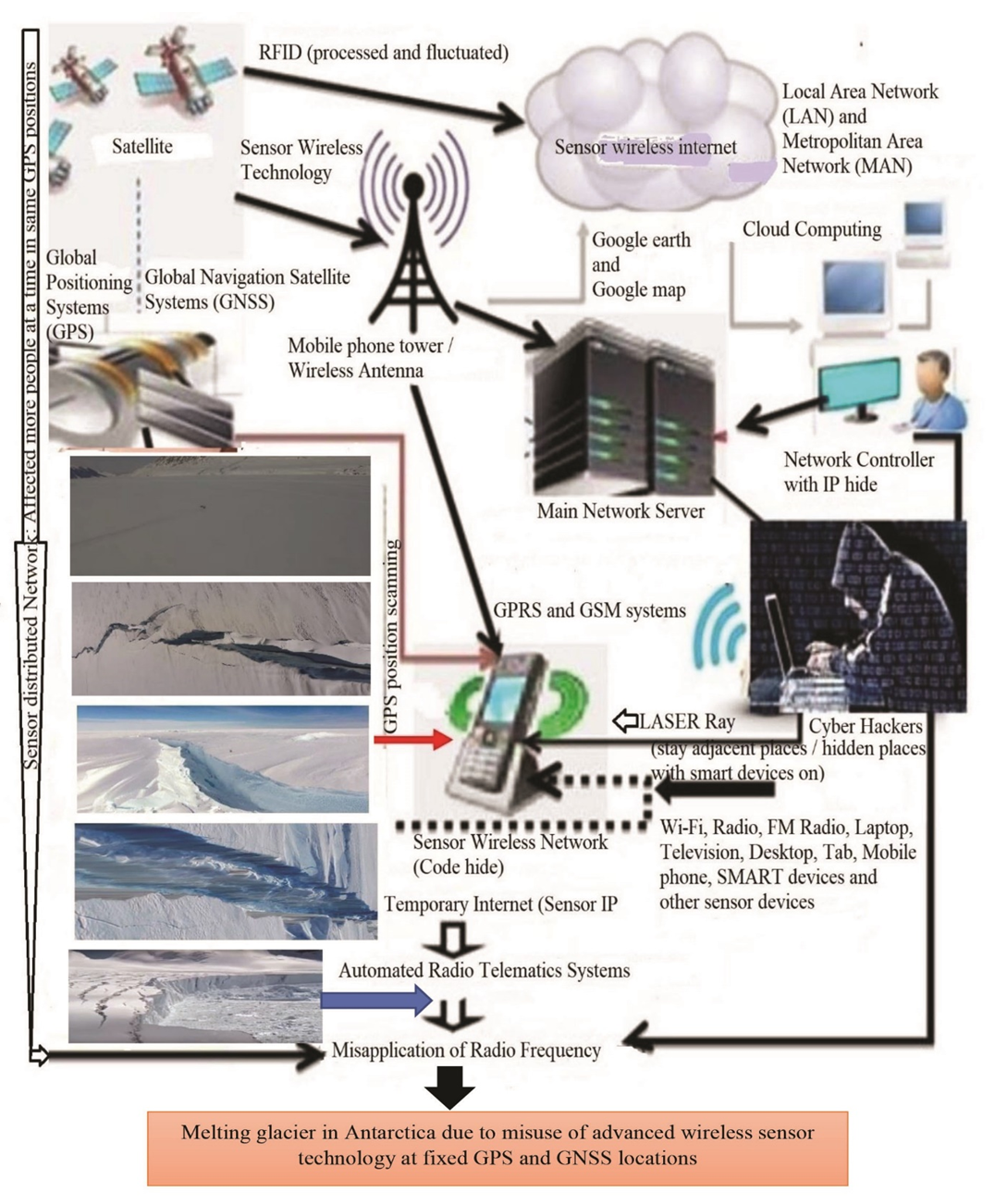 | Figure 15. Melting glaciers in Antarctic with the processed wireless sensor tracking |
3.13. Sensor Cyclone
- The study showed that sensor cyclones occurred in a fixed GPS location and GNSS position due to processed wireless sensor tracking, which as shown in Figure 16. The findings reflect on the climate crisis. The study represents tidal waves that also occurred in ocean zones and other climatic earth surfaces with advanced wireless sensor cloud tracking systems.
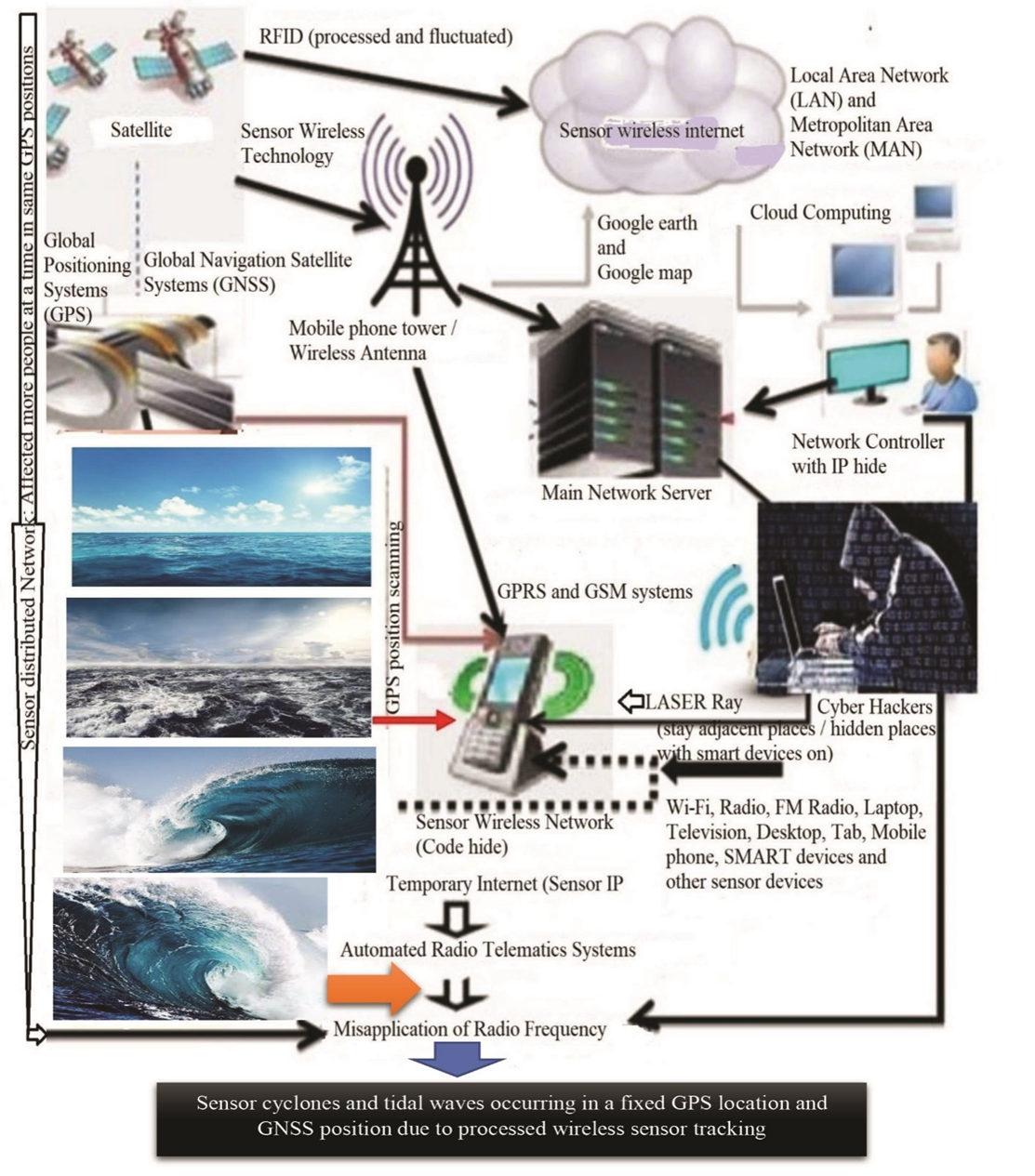 | Figure 16. Sensor Cyclone with the processed wireless sensor tracking |
3.14. Sensor Atmospheric Wildfire
- The study showed that sensor atmospheric wildfires occurred in a fixed GPS location and GNSS position due to processed wireless sensor tracking, which as shown in Figure 17. The findings reflect on climate change. The study illustrates on the loss of biodiversity, land degradation also occurred in forest zones and other ecological areas through advanced wireless sensor cloud tracking systems.
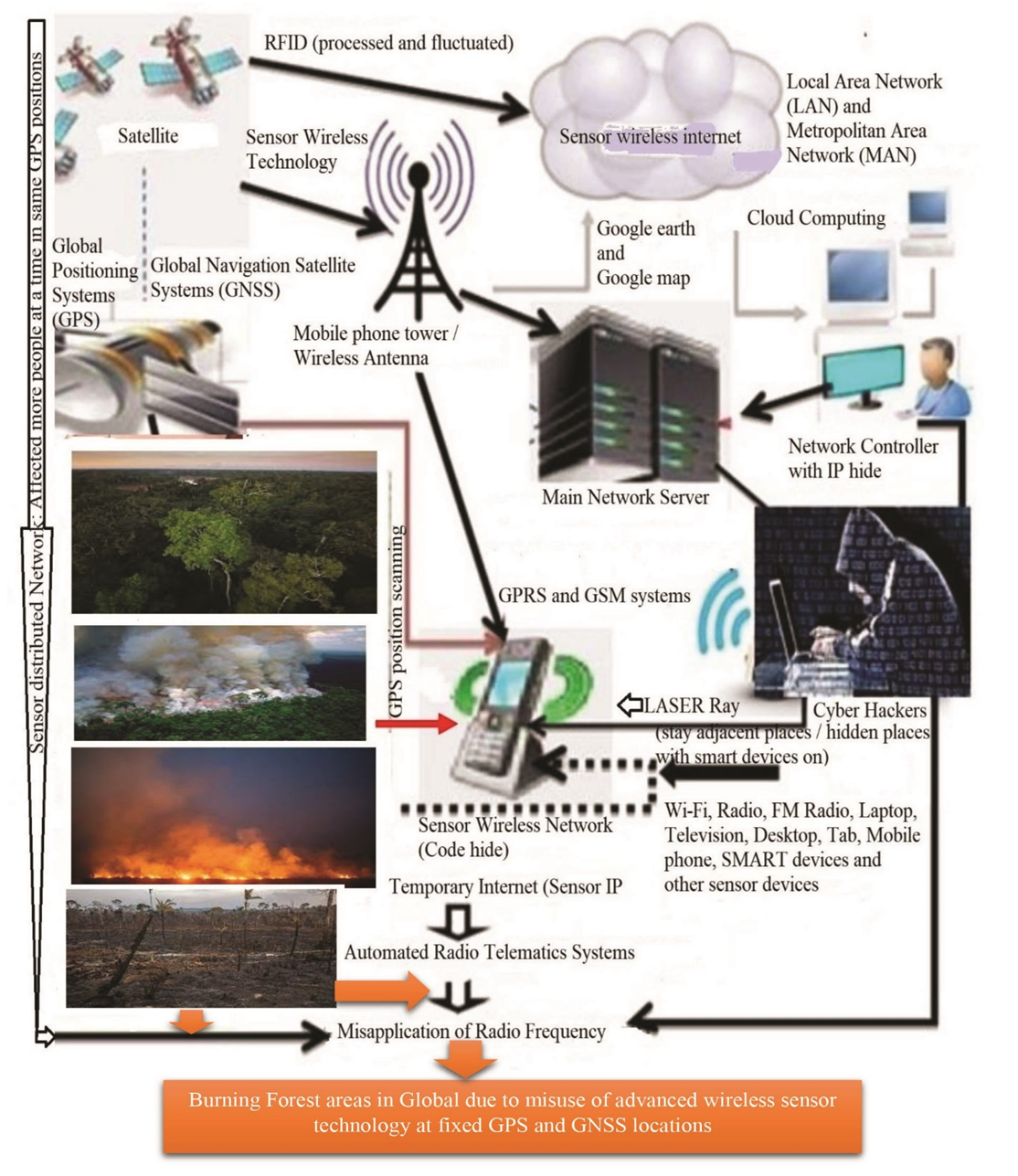 | Figure 17. Sensor atmospheric wildfire due to processed wireless sensor tracking |
3.15. Unexpected Sensor Effect on Glacial Mass
- The study showed that unexpected sensor effects on glacial mass occurred in a fixed GPS location and GNSS position due to processed wireless sensor tracking, which as shown in Figure 18. The findings reflect on climate change due to melting glaciers. The study illustrates flood prone zones and land degradation also occurred in land surface and other climatic disasters through advanced wireless sensor cloud tracking systems.
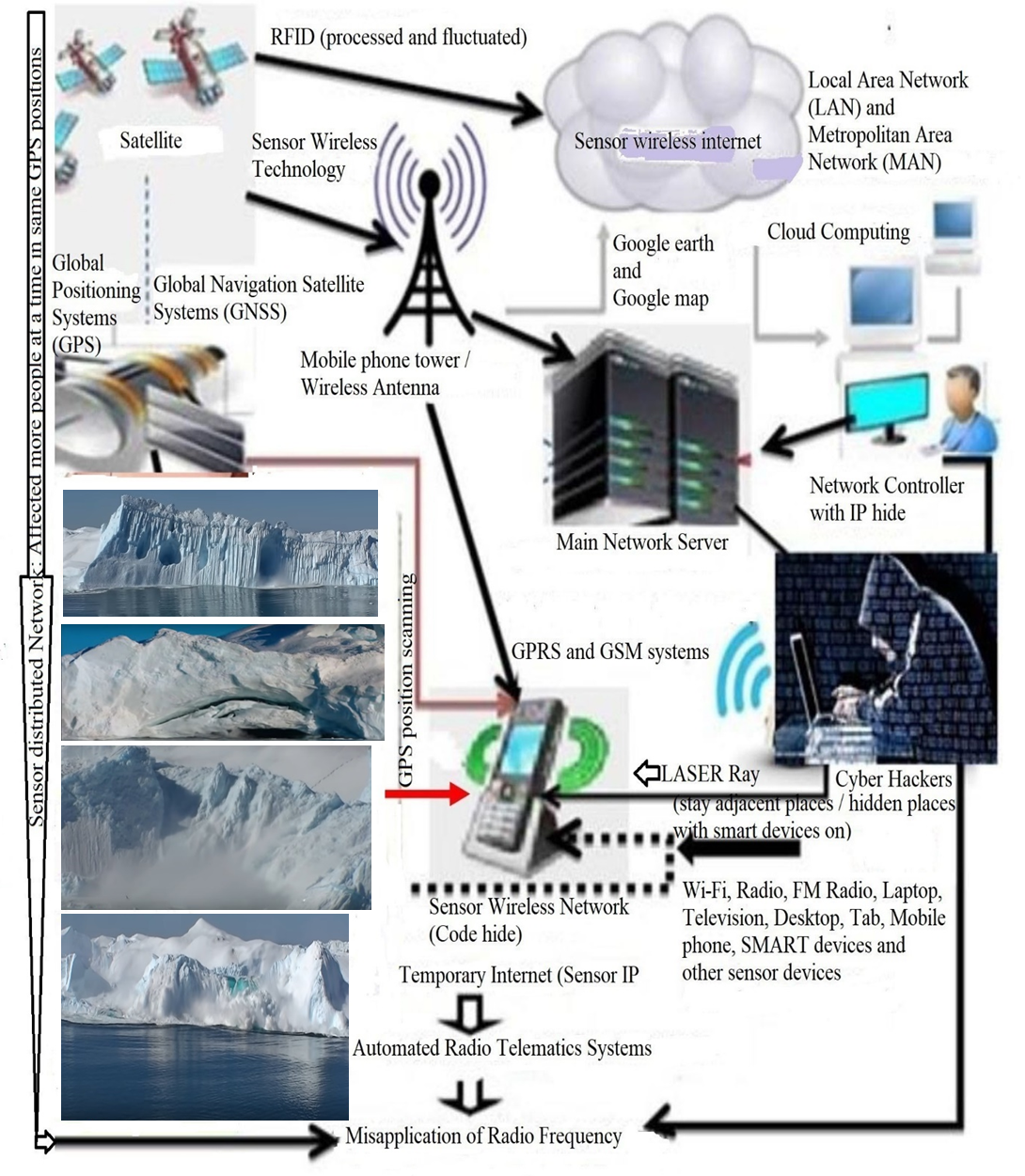 | Figure 18. Sensor atmospheric wildfire due to processed wireless sensor tracking |
3.16. Sensor Landslide
- The study showed that sensor landslides are occurring in a fixed GPS location and GNSS position due to processed wireless sensor tracking, which as shown in Figure 19. The findings reflect on climate change due to misuse of advanced sensor technology. The study illustrates on landslides, which happened in hill areas, roads, highways and riparian zones, riverine areas and other climatic area through advanced wireless sensor cloud tracking systems. Before starting landslide, sudden a horrible sound and noise occurred. Some sensor landslides listed in Appendix-3.
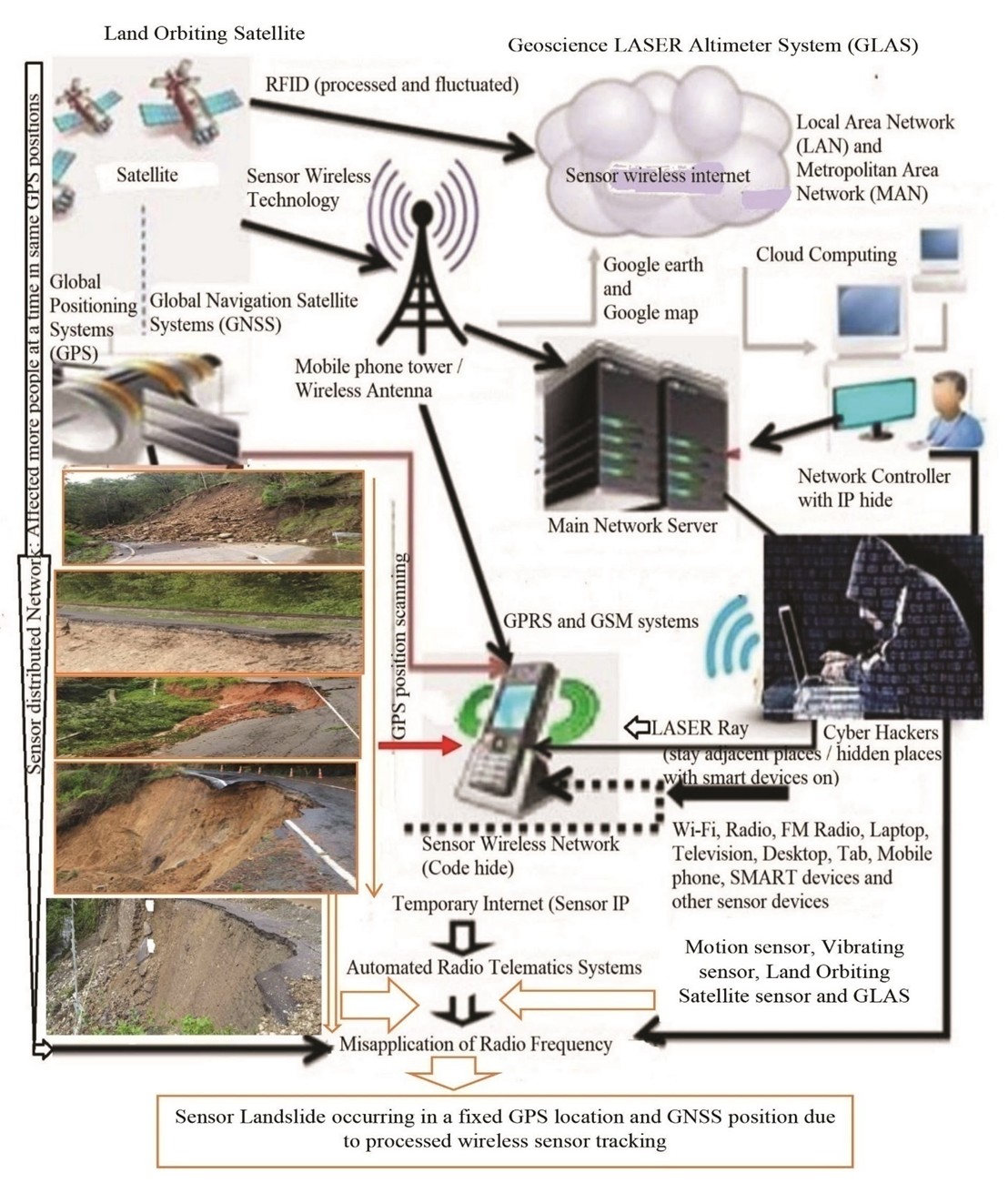 | Figure 19. Sensor Landslide due to processed wireless sensor tracking |
3.17. Sensor Tsunami
- The study showed that sensor Tsunami are occurring in a fixed GPS location and GNSS position due to processed wireless sensor tracking, which as shown in Figure 20. Before starting sensor tsunami, sudden a horrible sound and noise occurred.The findings reflect on climate change due to misuse of advanced wireless sensor technology. The study illustrates sensor tsunami, which happened in ocean, sea, river and riparian zone and other climatic areas through innovative wireless sensor cloud systems.
 | Figure 20. Sensor Tsunami due to processed wireless sensor tracking |
3.18. Sensor Artificial Earthquake
- The study shows that Sensor Artificial Earthquakes are occurring in a fixed GPS location and GNSS position due to processed wireless sensor tracking, which as shown in Figure 21. Before starting sensor artificial earthquake, sudden a horrible sound and noise occurred and moved objects swiftly. The findings reflect on climate change due to misuse of innovative wireless sensor technology. The study illustrates artificial earthquakes, which happen on land surface and riparian area zone and other residential areas through cutting-edge wireless sensor cloud systems.
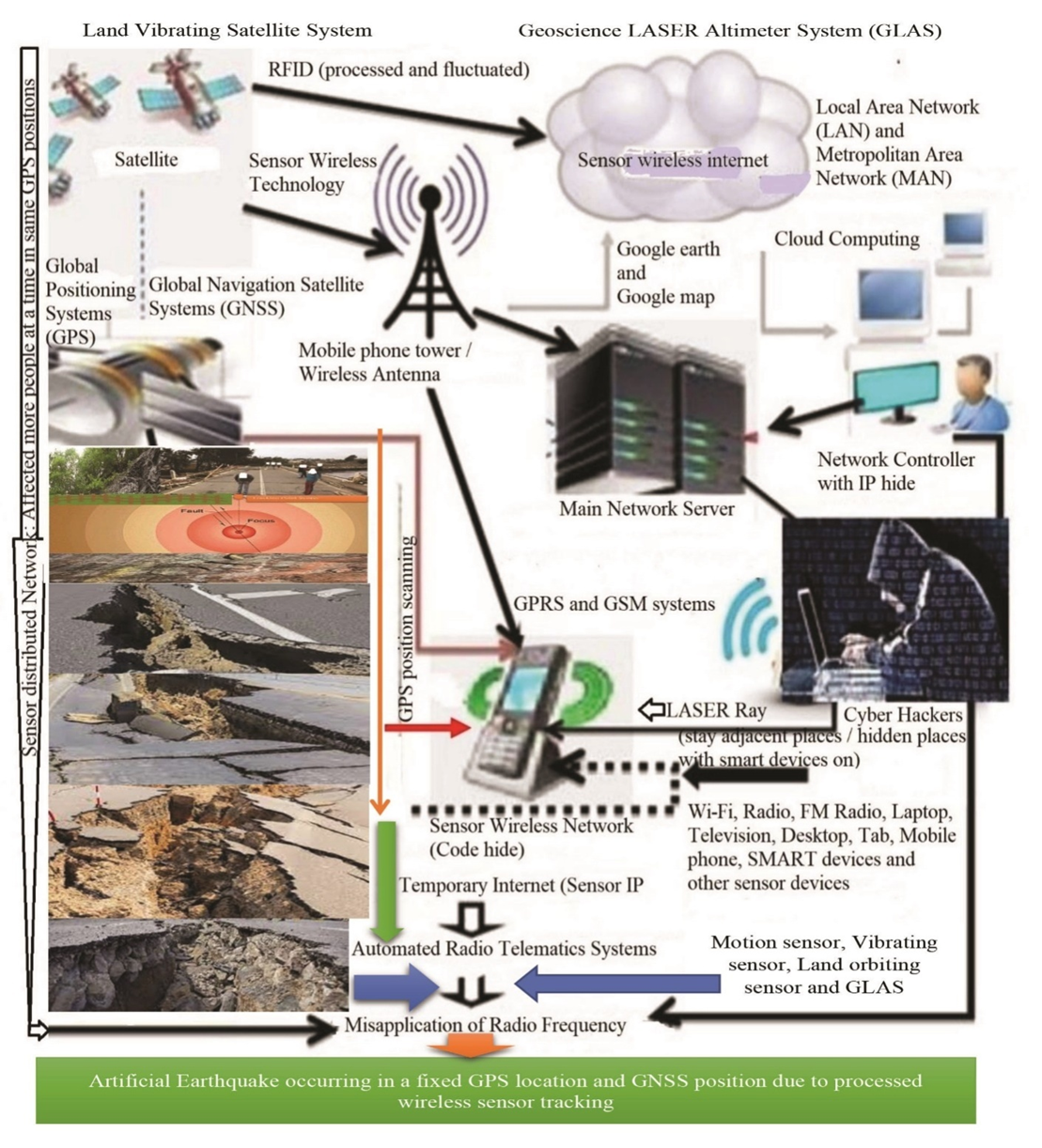 | Figure 21. Sensor Artificial Earthquake due to processed wireless sensor tracking |
3.19. Loss of Biodiversity and Climate Tragedy
- The study showed that loss of biodiversity and climate tragedy are occurred in a fixed GPS location and GNSS position due to processed wireless sensor tracking, which as shown in Figure 22. The findings reflect on climate change. The study illustrates the loss of plants, animals, birds, agricrops and land erosion also happens in climatic zones and other ecological areas through advanced wireless sensor cloud tracking systems.
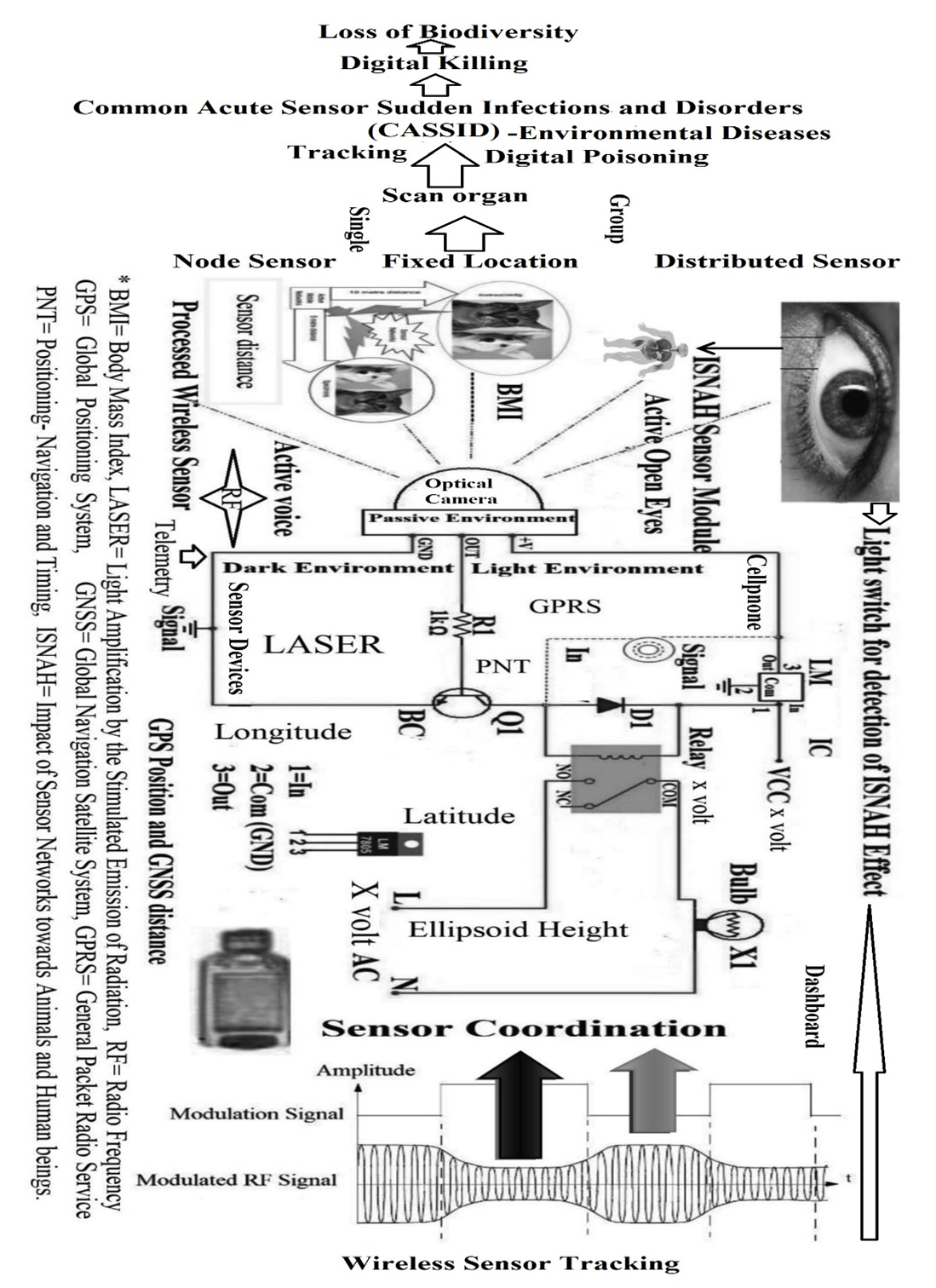 | Figure 22. Loss of Biodiversity due to processed wireless sensor tracking |
3.20. Exposure on Climate Change
- The ISNAPHOCE implies the Impact of Sensor Networks towards Animals, Plants, Humans, Objects, Climate change and Environmental issues. The awareness exposures include conference 11%, seminar 195%, sharing 51%, and research talks 25%, which as shown in Figure 23 [Appendix-1]. The research illustrates the awareness on climate crisis and environmental issues due to misuse of wireless sensor networks.
 | Figure 23. Awareness exposure on climate crisis and environmental issues |
3.21. Tracking Time to Climate Emergency
- The study showed that tracking time towards animals, plants and objects changed on individual’s characteristics in a fixed GPS location and GNSS position due to processed wireless sensor tracking, which as shown in Figure 24. The tracking time took 19, 12 and 15 minutes towards the individuals on excess weight, normal weight and underweight respectively. If individual’s is sensored earlier including retina scanning, voice coding, sensor fingering and fixed GPS location, then the tracking time will reduce accordingly. The findings reflect on climate change. The study illustrates the loss of animals, plants, birds, agricrops and other objects also affected in tracking climatic areas through advanced wireless sensor cloud tracking systems.
 | Figure 24. Tracking Time towards Animals and Objects at Climatic Zones |
3.22. Climate Vulnerability
- The study showed that Myanmar, Haiti, Philippines, Mozambique, Bangladesh, Pakistan and Thailand are at risks in the climate crisis due to lower scores on the Climate Risk Index (CRI), which as shown in Table 1. The findings reflect on climate change. The study illustrates the loss of plants, animals, birds and agricrops that are vulnerable due to lower CRI [Appendix], which also happened in the State’s climatic zone and other ecological areas through advanced wireless sensor cloud tracking systems.
|
3.23. Perception on Climate Sensor Technology
- The study showed that about 96% of respondents opined their risk in the climate crisis due to misuse of wireless sensor tracking towards human beings, animals, plants and objects at a fixed GPS location, which as shown in Figure 25. The findings reflect on climate change. The study illustrates secure climate sensor technology in mitigating climate catastrophe.
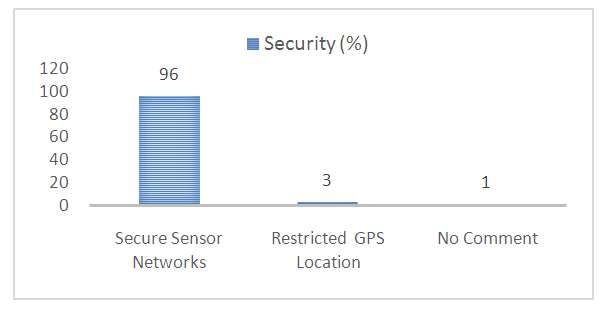 | Figure 25. Perceptions on the security of wireless sensor networks |
3.24. Global Temperature Fluctuation
- The results show that the global average temperature has warmed slightly but steadily by ~ 0.5°C, which as shown in Figure 26. The findings reflect on the climate crisis. The study illustrates the linear trend line on the value of temperature worldwide from the period of 1990 to 2020, but the values fluctuates unexpectedly from the year 2015 to 2020 [Appendix].
 | Figure 26. Fluctuations on global temperature |
3.25. Lower Tropospheric Global Temperature
- The results show that the lower tropospheric global temperature represents UAH and RSS values, which as shown in Figure 27. From UAH (University of Alabama in Huntsville) satellite temperature dataset, the RSS (Remote Sensing System) collected the satellite temperature record from SSMI (Special Sensor Microwave Imager). The findings reflect on the climate crisis. The study illustrates the linear trend lines on the value of tropospheric temperature worldwide from the period of 2000 to 2020, but the values fluctuates surprisingly from the year 2015 to 2020 [Appendix].
 | Figure 27. Lower Tropospheric Global Temperature |
3.26. Effect of Global Scoring on Climate Change
- The results show that the environmental performance index of different countries are varied due to the pandemic situation, which links with climate change. The United States, United Kingdom, Brazil, Russia, India and Indonesia are affected in the climate crisis due to deaths from COVID-19, which as shown in Table 2. The findings reflect on climate change worldwide from the study on Environmental Performance Index.
|
3.27. Sensor Climate Severity
- From the study, the results show that 58 global tropical cyclones occurred at 41-80 mph in the year of 2020, which is the highest, as shown in Figure 28. The findings reflect on climate change worldwide. The global tropical cyclones data 2020 are available in Appendix 2.
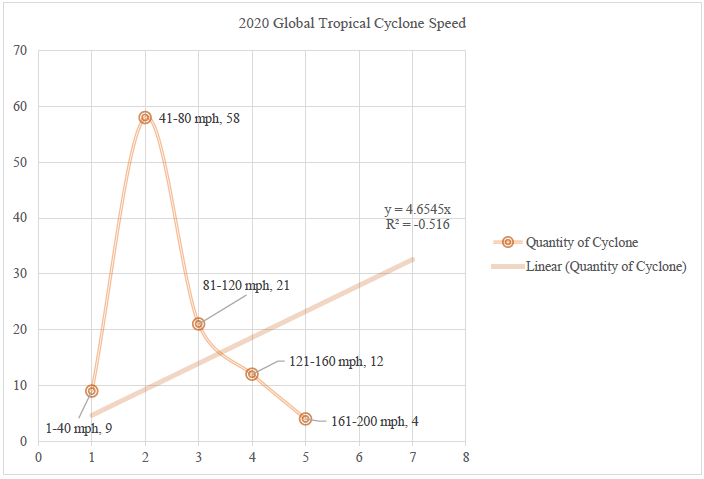 | Figure 28. Different global tropical cyclones with speed ranges |
3.28. Global Tropical Cyclones
- From the study, the results show the monthwise global tropical cyclones occurred in the year of 2020. August and September experienced the highest tropical cyclones, which as shown in Figure 29. The findings reflect on climate change worldwide. The some sensor cyclones are mentioned as examples, Damien, Ferdinand, Herold, Vongfong, Elida, Douglas, Genevieve, Laura, Bavi, Maysak, Haishen, Paulette, Sally, Teddy, Marie, Delta, Epsilon, Molave, Goni, Eta, Vamco, Iota, Gati and Yasa. The global tropical cyclones data 2020 are also available in Appendix 2.
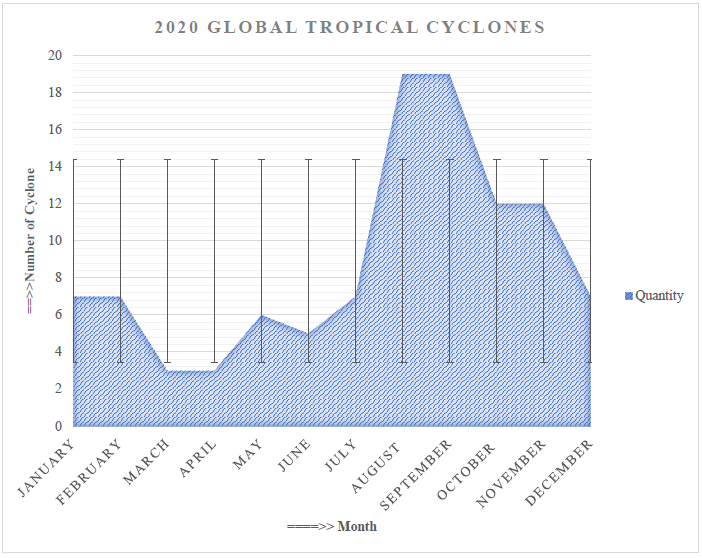 | Figure 29. 2020 Global Tropical Cyclones Monthwise |
3.29. Sensor Climate Crisis Worldwide
- The results show the different objects affected in sensor burning, wildfire, boiling, melting, cracking and oscillating characters at a fixed GPS location due to processed wireless sensor technology, which as shown in Figure 30. The findings reflect on climate change unexpectedly worldwide. The study mentioned the examples of wildfires in Amazon Forest, Brazil, California Forest in USA, and other countries in the world, indicating as a sensor climate crisis.
 | Figure 30. Global Climate Crisis due to processed sensor tracking |
3.30. Inference
- The study represents climate crisis due to the processed temperature sensor and electromagnetic force. When the temperature sensor increases, electromagnetic force also increases due to friction with atmospheric oxygen, which as shown in Figure 31. A high-powered radio frequency device is used to track people, animals, plants and objects and to change the climate. This is because it combines the friction response with atmospheric oxygen in the presence of processed temperature sensors (PTS) and electromagnetic force (EMF), which causes instantaneous climate change in the area. Whenever a person, animal, plant or object is in a certain GPS position, they all immediately feel abnormal rain, hot or cold. Residents of the area are facing a climate crisis as a result of climate change due to improved wireless sensors.
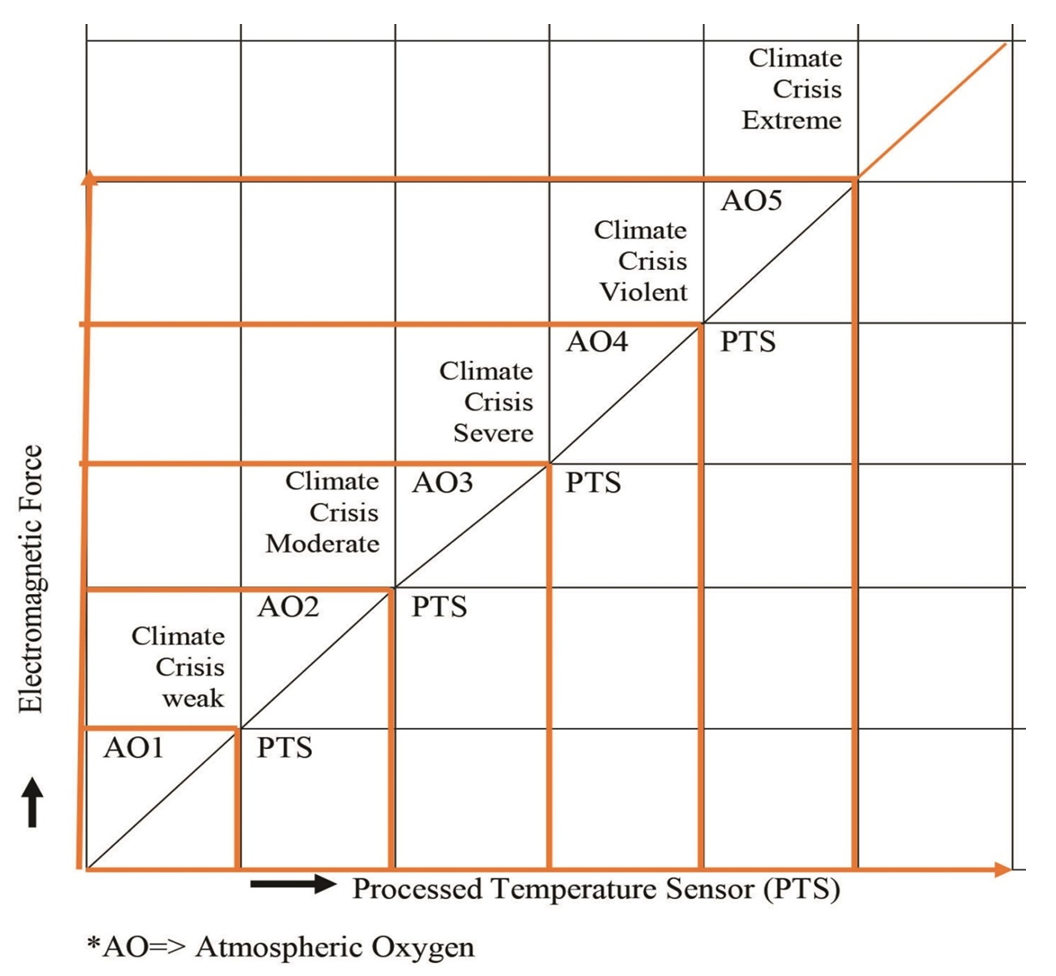 | Figure 31. Relationship between electromagnetic force and processed temperature sensor |
4. Discussion
- The study illustrates the root causes of global climate change due to misuse of wireless sensor technology. When a person sees a simple task with a hard eye, he complicates a difficult problem, so that the solution flows in a different direction. Such as the abnormal climate change of the present world. Thousands of scientists, climate specialists, meteorologists, environmentalists, policymakers and many others around the world are not finding the root cause of abnormal climate change, but misleading the general public in the media with misinformation, which is surprising researchers. Because, people are the root cause of almost all the problems in the world, again they are the pioneers in solving those problems, if they are skilled in the right skills. On the one hand, a class of people is destroying the world's climate, while on the other hand, they are wasting billions of dollars in various competitions including space research, shooting movies in space, sending spacecraft and space travel. They have no eye on the earth to form this peaceful world. In an interview with the BBC on the climate crisis, Prince William said: "We need some of the world's brightest and brightest people who will repair the planet later this month without trying to find a place to live." At the COP-26 climate summit in Glasgow, Prince William warned leaders not to do enough, but to use cunning words and phrases. Prince William said: "I think it's important to find out what the solution is by identifying the issues very clearly and honestly. We don’t want to hear any more clever rhetoric and words instead of taking enough action.” Prince William expressed concern about young people’s concerns about climate change. "It will be a terrible disaster when his eldest son Prince George, 30, will speak on the issue," he said. The Duke of Cambridge said: "We see that everyone is concerned about climate change. Young people are growing up. Basically, their whole future is under threat. It’s creating unrest among them, which is very worrying. ’Prince William added that his father, the Prince of Wales, is known for his long-standing commitment to the green issue. When he first started talking about the climate crisis, he had to go through a ‘difficult path’. At the time, Prince William added that his late grandfather, the Duke of Edinburgh, had begun to show interest in the British royal family. Prince William said, ‘If we are not careful, what we are doing now is threatening the future of our children. I think it's unfair" [16]. Although the effects of climate change are not evenly distributed, the Earth has already reached the limits of recent extreme weather events and adaptations [48,49,50,51,52]. But transdisciplinary research can support collaborative solutions to improve understanding of the local context and manage adaptation constraints on a local scale based on the knowledge, experience and proper use of sensor technology in the local community [53]. Achieving the goal requires reducing global carbon emissions by 45 percent by 2030, and bringing it closer to zero by 2050 [39]. But as promised at the Glasgow conference, global temperatures will continue to rise by 2.4 degrees above pre-industrial levels, according to a report by Climate Action Tracker. Developing countries say they are suffering the most, even though they have lower carbon emissions than rich countries. Climate change is now wreaking havoc around the world, such as floods, droughts, and wildfires; And the poorest countries are in the most trouble with this. They demanded that rich countries not only reduce their carbon emissions, but also provide financial assistance to the affected countries.
4.1. Impacts of Climate Change
- There are several unexpected effects of advanced wireless sensor technology on climate change. The key challenges demonstrate with different parameters as below.
4.1.1. Climate Criminals
- The ISNAPHOCE study identified the climate criminals’ contract signed with the Chief Political Leader for a fixed time to show their greed to win national elections through the misuse of sensor technology, so that their illegal activities spread all over the world through various factions. In 2009, they signed into political parties illegally with unwanted terms and conditions. The terms & conditions include that the cyber hackers will have won the signed political party in the general election and the elected government will support their illegal activities according to agreement. This Chief Political Leader was elected as Prime Minister with the help of cyber hackers. Then they have been occurring illegal activities at national, regional and global levels with clouding wireless sensor network systems. Climate criminals with their pseudonymous names as shown in Table 3.
|
4.1.2. Climate Change Income Inequality
- Nine out of 10 top climate economists in the world believe that climate change will deepen income inequality between rich and poor countries. So, most economists have called for urgent action to reduce global warming emissions. A study published by the Institute for Policy Integrity at New York University found that the effects of global warming could create even more difficult disadvantages for countries with already high economic pressures and high poverty rates [17]. This is by far the largest global expert study on the economy of climate change, according to Reuters. About three-quarters of the 630 experts say "immediate and drastic action" is needed to reduce carbon emissions. Economists believe that governments could underestimate the potential costs of climate change. The ultimate concern about the risks of climate change has been created among humans, animals, plants and other organisms. The study found that by 2025, the potential damage from climate change will be 1.6 trillion US dollars every year [59,60,61]. If the current warming trend continues, by 2075 this loss will reach 30 trillion US dollars per year. The biggest impact will be on developing countries. Especially those agricultural countries. According to researchers, agricultural dependence, including biodiversity, will be at risk of overheating. Eighty percent of economists surveyed said climate change would increase inequality in the country. The distance between rich and poor countries will increase. And the misuse of information technology will increase. The cost of reducing carbon emissions is also falling sharply, researchers say. The use of solar and wind energy is increasing. They hope to increase the use of such cost-effective methods [80].
4.1.3. Rapidly Increasing Carbon Emissions
- Discussions are underway around the world to reduce carbon emissions to prevent climate change and environmental pollution. But in the meantime, its emissions from the world's richest countries have risen sharply. A new study has found that carbon emissions are rising sharply in the world's 20 richest countries. According to The Climate Transparency Report, carbon dioxide emissions among G20 members will increase by 4 percent this year. The rate dropped to 6 percent last year due to the Corona epidemic. China, India and Argentina are also on track to exceed their 2019 emissions levels, the report said. Researchers say continued use of fossil fuels is undermining efforts to control temperatures. The world is now 1.1 degrees warmer than in pre-industrial times. Restricting rising global warming is extremely challenging. The new research report does not show that rich countries are taking swift action to address this challenge. According to the Climate Transparency Report, gas consumption in the G20 countries increased by 12 percent from 2015 to 2020 [18]. The report also highlights the growing use of solar and wind power in rich countries. Last year, a record number of solar panels were installed in the G20 countries. In 2010, the use of recyclable energy was 10 percent, but this year it has come down to 12 percent. Politically, the G20 has also made significant progress in reducing carbon emissions. Most G20 countries have recognized the goal of reducing carbon emissions to zero by the middle of this century. Ahead of the Glasgow conference, all members of the alliance agreed to adopt a new carbon plan by 2030. However, China, India, Australia and Saudi Arabia have not made any promises in this regard [18].
4.1.4. The World in Existential Crisis on Environmental Issues
- The United Nations Intergovernmental Panel on Climate Change (IPCC) released its latest report last August, setting a record for the hottest and most devastating summer [18,59]. According to the report, there have been unusual floods in northern Europe and China this summer. The blaze has spread to several places in the United States and has spread to almost all parts of the world. The report says the current global warming crisis is now almost unchanged. In this situation, we can try to prevent the overall environmental decline. Glaciers in the polar regions and mountain peaks will continue to melt for the next few decades, the report said. Few countries have more glaciers than anywhere else in the world outside the polar or tundra region, such as Pakistan, India, China, Afghanistan, Maldives, Bangladesh. The country's environment and agricultural system play the biggest role in making its economy sustainable. And that agricultural system is said to be totally dependent on the various rivers flowing down the glacier. If the IPCC report is correct, it will run out of water by 2050 in a few more countries, including Pakistan, and many people, animals and plants will be exposed to the devastating effects of global warming [71]. However, the heads of state of those countries are not showing any minimum activity to protect their future. The biggest crisis the whole world will have to deal with in the next few decades is global warming. But they do not have a headache with this. The governments of these countries seem to be extremely indifferent to the impending crisis. Already these countries are facing a mountain-like environmental crisis. Many people are dying in floods in these countries, floods are coming again and again, repeated landslides have cut off normal communication, and droughts have become a regular occurrence. Forests are being destroyed by fire through sensor technology and landslides have occurred. In the valley, the tree-smugglers are cutting down the big trees growing on the hills and destroying the hill forests. Local and international researchers say that if deforestation in these countries does not stop quickly, it could have dire consequences not only in the region but around the world. The impending climate change needs to be addressed by uniting in a concerted effort to learn about the harmful effects of global climate change and ways to address it. Today, the whole world is in the throes of a climate crisis. The effects of climate change are not limited to one or two sectors. It has had a negative impact on the lives of people all over the world. In this situation, two paths are open for policy makers all over the world. One is to move forward on the path of certain destruction. The other is to collectively stand up against these anti-environmental activities. We have to choose which way to go. Otherwise, future generations will not forgive us. Because the world's climate is changing abnormally, we are all moving towards a terrible future. The world is in a critical moment right now. The responsibility for the damage done to our habitats, forests and environment on earth must rest on each of us. The damage caused by climate change is irreparable. People are making the world uninhabitable. However, this unsuitable habitat has made the world unsuitable not only for humans, but also for other animals and plants.
4.1.5. Dealing with Climate Change
- Clouds are significant in controlling the Earth's climate, terrestrial atmospheric dynamics, thermodynamic chemistry, in-cloud GPS sensor and radiation transfer [54]. Satellite imagery is one of the most powerful and important tools used by scientists to study earth and space research remote sensing technology [55]. Clouds can both work to warm and cool their lower surface due to the processed satellite images depending on the time of year and the changing environment where they form and exist [56]. But clouds warm cool surfaces through extended wavelength radiation (i.e., positive cloud radiative effect) and shortwave shading effects (i.e., negative cloud radiative effect) [57]. In this way, Greenland and Arctic clouds can profoundly influence surface radiation and thus surface melt and the net effect, warmth or cooling, strongly depends on the location [58]. All of the world must work together to tackle climate change. There must be a consensus on setting new goals for the next 10 years, which will be a milestone as a decisive decade. The new goals that science is setting for us must be achieved. Policymakers say everyone should pay special attention to the bold steps’ climate activists are taking to prevent environmental disasters [80]. We need to show sincerity in tackling global warming and heeding the warnings of young climate workers. Everyone needs to be made aware of the proper use of information technology, everyone needs to realize its importance through constructive discussions and implement it.
4.1.6. The Horrors of Climate Change
- Due to misuse of wireless sensor technology, extreme heat is going on in different countries of the world. In the hot city, people are in a state of suffocation. In a country with a subtropical climate like ours, hotness is extremely uncomfortable and unsettling. One of the variables of the weather is the increase in relative humidity, which on the one hand poses a risk of dehydration in the human body, on the other hand, unbearable heat creates inactivity in daily activities. Global climate models are predicting that the crisis could be protracted and exacerbated in the future. The severity of flash floods, droughts and storms may increase. And the unequal victims of the hostile behavior of the weather can be seen all around us, including our cities, ports, markets, farms, forests, some of which are already visible. Hostile weather threatens the resilience of these existing infrastructures. As a result, hostile weather is increasing the health risks of overpopulation in villages, towns and cities, such as coronavirus. Again, one of the indicators of climate change is the variation in day-night temperature. The study found that day and night temperatures vary most in Dhaka, Bangladesh, then in Delhi, India. In Singapore, Sri Lanka and Malaysia, on the other hand, the difference is negligible compared to other years [78,79,80]. In a word, villagers and city dwellers have to breathe in the heat even at night, like the bright light of the sun on a bright day. Excessive population density, climate-sensitive building materials, excessive human activity and extreme lack of greenery are the main reasons for the rise in temperature in these villages and towns. Large-scale weakening of southwest monsoon winds and rising surface water levels in the oceans are also affecting the country's heat. If such a situation continues, the swelling may take a terrible form in the future. As a result, the pressure on the country's energy, water and other resources will increase but not decrease. Without it, cities may lose their habitation. Although no single solution to global climate change has been discovered to date, cities can play an effective role in mitigating climate impact as they are at the heart of social, administrative, economic and cultural life. In a disaster-prone country like ours, the role of cities in determining adaptation strategies can be quite fruitful, if a thorough analysis of the environmental conditions of cities can determine the limitations of knowledge. This is because climate and environmentalists and policy makers need science-based information, on the basis of which strategies to adapt to the climate can be invented. Many speak of replacing the strategies of the developed world. It should be kept in mind that effective adaptation strategies need to combine the geo-natural and demographic features of the area through information technology with local geographical knowledge, especially local innovation. So, no strategy in a foreign city will work in our case. For example, in the city of Seoul, 30 meters high trees are being planted to reduce the risk of heatstroke, so that the spread of shade increases. In São Paulo, Brazil, reducing greenhouse gas emissions is giving financial incentives to city dwellers to be frugal in using water and electricity [78]. A country or region determined by the risk of global climate change is just like that; Similarly, the extreme lack of coordination of the governing bodies of the city or region and the extremely weak environmental governance are equally responsible for the current state of the urban climate. In other words, the state of the policies or laws to increase the livability of cities is a lot like eye-washes. Of the abnormalities that can occur due to the adverse effects of climate, hotness is the most frightening. But hopefully, determining the future course of this phenomenon is much easier. As river erosion, increased salinity in coastal areas or erratic rainfall will increase the rate of migration from rural to urban areas in the country in the coming days, which may also increase the pressure in medium cities. So, our future may be bleak if the adaptation strategies are not mastered from now on. One of the most effective ways to adapt to the pressures is through planned urbanization, which helps to make development sustainable, including increasing the quality of life. Inflammation is a relatively recent issue. It should be kept in mind that the sooner urban climate change or climate change policies can be formulated, the sooner economic losses can be mitigated, including improving the quality of life of urban dwellers. But first and foremost, human beings need unlimited control over nature.
4.1.7. Negligence in Dealing with Natural Disasters
- Sensor Artificial Earthquakes and post-earthquake sensor tsunamis have caused the most disasters due to the climate crisis. But in spite of so many disasters, the big countries of the world have not yet taken any steps to protect the environment, which is very sad. The world is facing severe natural disasters due to climate change. Disasters such as floods and heat waves have increased fivefold in the last 50 years [61,63]. More than 20 lakh people have died due to the disaster at this time. The loss was 3.84 trillion US dollars [60,61,64]. Nowadays, natural disasters are a constant companion in the world. Environmental pollution still does not stop. There is no stopping the arms race, and the misuse of sensor technology. Not to mention cracks in all levels of soil, water, and atmosphere. The incidence and severity of extreme weather-related disasters are increasing due to climate change. As a result, natural disasters are raging all over the world. Somewhere there is a storm, somewhere there is a flood, somewhere there is a drought, somewhere there is a fire, somewhere there is a cold wave. There is no benefit in blaming nature. Because nature is the cause of human misdeeds. People act against nature. Nature also suffocates in the anger of losing resources and balance. At one point, he sat down and clapped his hands in anger. Nature destroys the town and the people. Disasters are natural or man-made events or extreme situations that disrupt normal human life, damage property and the environment, or cause loss of life. Earthquakes, volcanic eruptions, floods, tidal surges, tsunamis, droughts, torrential rains, wildfires, cyclones, thunderstorms, epidemics, famines cause extensive damage to human society. This has adverse effects on the economic, social and cultural spheres. Disasters also severely damage development progress, planning and investment. Socio-economic development is hampered. Every day thousands of people are lost and exhausted due to these disasters. Among them, low-income countries cannot stand up because of disasters. As a result, due to negligence in dealing with the problem, it is instantly damaged. The big developed countries who are speaking out against fossil fuels that are harmful to the environment are the ones that are using these fuels the most. This has led to an increase in harmful carbon dioxide emissions. The Earth's protective ozone layer is depleting. Natural disasters such as droughts, fires, torrential rains, storms, tidal surges and cold spells are on the rise. Biodiversity is endangered by counting its cost. Ecology under threat. As if no one has anything to do, we are like silent spectators watching the decay of the world. Crops, houses, cattle, plants — everything is destroyed. The country's agrarian economy collapsed. According to the 2017 Global Climate Change Risk Index, Bangladesh ranks sixth in the world as a climate risk country [65,66]. Floods and cyclones cause a loss of 3.2 billion or Tk 25,600 crore every year in Bangladesh, which is 2.2 percent of the gross domestic product (GDP). If the global temperature rises by just 1.5, the danger in our region will increase manifold. As a result, countries around the world need to play a stronger role in tackling climate change and raising awareness, including enhancing regional capacity to deal with disasters [74,75,76,77]. We need to play a more proactive role in tackling climate change in our own interests and continue our efforts to compensate them for their carbon emissions from the developed world, as well as the promised grants from the Climate Fund. If all the countries do not come together to save the people from the disaster caused by them, mankind may have to pay huge compensation. So, everyone should be aware to protect the environment [19].
4.1.8. Reducing the Risk of Disaster
- Dynamic initiative is to increase the awareness of the people and the government in reducing the risk of disasters. Every October 13 is International Disaster Mitigation Day. These days, efforts are made to create public awareness about the importance of disaster risk reduction as well as to encourage and strengthen the political will of the government. At the same time, in this case (in terms of risk reduction), the achievements of the people are identified and arrangements are made to encourage and celebrate them. In the eighties, the level of disasters in different countries of the world began to increase abnormally. Following the catastrophic floods in Bangladesh, the UN General Assembly in 1978 discussed the growing risk of disasters. It was decided that as the risk of disasters is increasing day by day due to various reasons, everyone should work together to reduce the workload like relief and rescue and to reduce the risk of disasters for the protection of human life and property. The cost of risk reduction is low. The initiative is aimed at raising awareness among the people and governments of member states to reduce the risk of disasters. Together they decided to work tirelessly to achieve the seven goals by 2030. These seven goals are fulfilled by 2030, such as: [78,79,80].• Minimize loss of life as much as possible.• Reducing the number of people affected by the disaster. • To keep the economic activities going. • To keep the infrastructure active. Achieving international cooperation in risk reduction. All information on risk reduction will be available to people. By 2030, all member states need to develop disaster risk reduction strategies at the national and local levels in their respective countries. No infrastructure can be built or demolished in rivers, wetlands, coasts, Sundarbans, Madhupur, hills or the sea, bypassing the risk mitigation strategy. Emphasis has been placed on strengthening disaster risk management governance as well as increasing the field of knowledge about disaster risk reduction. Priority has been given to investing in risk reduction and building stronger installations. We have recently seen in the housing project what the consequences could be if there is a lack of governance for disaster risk management. Last year's theme was 'Good Governance in Disaster Risk Reduction, Ensuring Sustainable Development Goals 2030.
4.1.9. Climate Change as a Major Threat to Public Health
- Sensor Unexpected Climate Change (SUCC) has emerged as the single biggest threat to human health worldwide. Governments and policy makers of the countries need to take urgent steps to address this threat. As a result, it will be possible to save the lives of at least 6 million people every year. This was stated in a special report of the World Health Organization (WHO) ahead of the UN World Climate Conference COP-26 to be held in Glasgow, UK. Fossil fuels are killing us. Climate change has now emerged as the single biggest threat to public health. It is time to take urgent action to address the threat. The impact of climate change on public health is increasing day by day. The COVID-19 pandemic has exacerbated the crisis. In this situation, there is a moral obligation to talk about the issue. In particular, countries that are playing an active role in climate change through the use of fossil fuels have a responsibility to stand by countries at risk. Climate change, environmental pollution, and extreme hostile weather disrupt the food supply chain, killing 6 million people worldwide each year [20]. Health workers are fighting against the corona epidemic. In the meantime, they have been vocal about the impact of climate change on public health. Climate change is having a negative impact on public health. Various initiatives have already been taken around the world to combat climate change. However, it is time to take urgent steps in this regard. Otherwise, global health care cannot be saved.It is possible to reduce air pollution deaths by 60 percent worldwide just by following the right policies, health workers are fighting against the Corona epidemic [1,63,64]. In the meantime, they have been vocal about the impact of climate change on public health. Now is the time to listen to them. Policy change on climate change is urgent. Reducing global warming in response to the impact of climate change on public health, promoting sustainable food production, climate-adapted health care, and environmentally friendly housing and transportation systems. In addition to the climate crisis, the Corona pandemic has had a devastating effect on society and the economy. It has threatened people's lives. Reduced performance. The impact of the two crises has further highlighted the picture of inequality towards communities at extreme risk. To solve this problem, it is necessary to focus on green recovery policy and increase investment. Coronavirus and climate, both need to take integrated global initiatives. Because, until everyone is protected, it will not be possible to ensure complete protection of anyone. Changes in the country's average temperature and rainfall are visible. This is having an adverse effect on physical and mental health. Despite being one of the most vulnerable countries in the world, Bangladesh is significantly tackling the effects of climate change. However, in order to find stronger evidence of the adverse effects of climate change on physical and mental health, Bangladesh's health system needs to be strengthened to prevent the spread of climate-related diseases including (i) Melancholy increases in the dry season, (ii) The rainy season is getting longer, (iii) Suddenly rainfall is declining in the diverse regions, and (iv) The risk of dengue is increasing in different places [78,79,80]. Besides, CASSID affects on public health linking climate change [3].
4.1.10. Impact on Mental Health
- Researchers illustrate the seasonal effects on mental health increase due to climate crisis. There is growing sadness and anxiety among people due to climate change. It varies by age, gender and GPS location, misappropriation and abuse of wireless technology. When there is uncertainty, there is anxiety among people, particularly females. And sadness gives birth to melancholy. Climate change is causing misery in the lives of many, uncertainty in the lives of many. This increases the risk of mental health [20,21].
4.1.11. Augmenting the Insect-Borne Diseases
- Studies have shown that climate change is creating a favorable environment for insects, such as mosquitoes or gnats. In the monsoon season, 24.5 diseases are caused by insects. In the dry season, the rate is 14.4 percent [21]. The incidence of insect-borne diseases is higher in urban areas than in other parts of the country. On the other hand, water borne diseases are more prevalent in the dry season than in the monsoon season. Respiratory diseases are also more common in the dry season. Researchers say there is a link between increased humidity and average temperatures and an increase in waterborne diseases [11,20].
4.1.12. Change the Boundaries of the Seasons
- Bangladesh was a country of six seasons. But the difference in seasons is becoming blurred due to climate change. The summer of 2019 was hotter and lasted longer than 1901 [20,21]. Winter, on the other hand, is less stable and the temperature has risen. Researchers say the monsoon season is likely to be longer in different countries and regions [63]. At present the bottom of the river is much higher than the surrounding plains in many places. Wherever the main stream of water goes, there is erosion and landslide.
4.1.13. Myth about Climate Change
- The report of the Intergovernmental Panel on Climate Change (IPCC), formed by the United Nations, says that as global warming continues, human civilization is heading towards the ultimate danger [60,61,62]. And the people are totally responsible for that [48]. The root cause of the unpredictable climate change in today's world is nothing but the misuse of advanced sensor technology. A group of cyber hackers are doing damage with sensor technology all over the world as climate criminals. These climate criminals are using wireless sensor technology to control the wind speed at the designated GPS location or satellite distance. They are misusing the sensor technology to create sudden storms, cyclones, tornadoes, artificial earthquakes, sensor tsunamis and wildfires. As a result, there is a sudden feeling of uncomfortable heat or sudden cold, and then there is a sudden fog and cloudy sky in certain places. And a lot of fish and aquatic animals are dying in ponds, canals, rivers and seas. Flying planes and helicopters are crashing in the sky, accidents on roads and highways are increasing. Moreover, cracks in roads, broken bridges, fires in buildings, load shedding - this is how the world's climate is changing. Many climate scientists, researchers, scholars, politicians and policy makers are lying about the current climate change. Many are talking about greenhouse gas emissions, obsolete climate policies and excessive burning of fossil fuels. In this way, many more are lying about the misconceptions about climate change. They are lying and presenting in meetings with various misconceptions at climate summits, conferences, seminars, roundtables and academic talk shows, with which there is no compatibility with the current unpredictable climate change. In this way, fake information given by cyber hackers is being spread in the media and ordinary people are believing it in the open sky with their eyes closed. Because, the general people have no proper research, no advanced sensor technology. They just lack leadership, and have no choice but to be immersed in false media. Lacking the right knowledge, they have also lost the courage to search for false media properly and broadcast it to the right audience. Because hacking, tracking, network gateway blocking and digital poisoning are occurred by cyber hackers all around. For these reasons, many people, animals and objects are getting sick, dying or getting damaged due to processed wireless sensor networks. Still some scientists and researchers believe that these changes are due to global climate crisis. But research shows that cyber hackers are responsible for these changes through the misuse of sensor technology. So, it is important to use a secure wireless sensor network to mitigate the climate crisis.
4.1.14. Climate Justice
- In today's world, climate justice is a concept that addresses the ethical, environmental and technological relative dimensions of climate change. Climate justice redistributes on decision-making power back to vulnerable communities are systematically impacted by (a) preparation climate-education, (b) hold representative leadership, (c) use the power of proscribe, (d) raise the voices of impacted publics, (e) proper use of secure wireless sensor network, and (f) ensure equal and fair mitigation without political procrastination and technological descrimination. The climate global administration establishes climate justice among the state members on the ground of race, religion, gender, colour, national origin, participation, implementation, and enforcement of climate laws, regulations and policies [35]. As for example, at the COP26 Climate Summit, Tuvalu, Antigua and Barbuda announced the formation of a commission to take a modest but important step towards climate justice [36]. Due to sensor technology climate changes are erupted that results many flora and fauna at stake. The globe may be exterminated if climate changes are not protected. With the negligence of the influential states as well as the sensor criminals the world is facing countless problems and heading to extinct. To preserve the environment and protect the people from the danger of environmental degradation, movement like ‘Climate Justice’ is initiated. Different countries of the world are differed in making laws for the environmental preservation. Some provides strong environmental laws where others are not. There are some laws of the United Nations (UN) that need to be followed. But the powerfully countries are disobeying the rules set by the UN. Since the UN rules are not mandatory, no action is taken against the violating countries. United Nations should make necessary rules providing vehement actions to the state-sponsored violating countries. It should have also imperative powers to implement the laws. UN may also play a role imposing sanctions on the violating countries. Moreover, compensation should be imposed on the countries perpetrating natural calamity through using sensor technology. Unification of Code of the global world is required to be taken to tackle climate changes. Individuals committed environmental crime through sensor technology should be identified and be under the custody of law. Proper monitoring is perquisite to such types of crime. Lack of vigilance paves the criminal a way to commit crime [37].
4.1.15. Public-Political and Technological Supports
- The way in which human activity has changed the climate of this earth in a short period of time has not happened in millions of years. And in many cases, there is no way to correct this change, which is leading mankind to inevitable consequences, scientists have warned [48]. The current unwanted climate change is a man-made technological crisis due to the misuse of wireless sensor technology in certain GPS and GNSS locations, which has been identified in higher studies and published in international journals. Wireless sensor technology can be easily used in all tasks, so it is a blessing for everyone. Again, due to the lack of proper security, its misuse is constantly increasing, so it is also a curse for us. If the use of safe and secure wireless sensor technology and policies is not ensured very quickly, the effects of climate change will increase thousands of times, making this world uninhabitable for all. Some climate scientists and researchers are talking about greenhouse gas emissions - this is their misconception. Today's research will change their minds and encourage everyone to study climate technology, so that the world's climate will be peaceful. Otherwise, everyone in the world will suffer because of their wrong research. We all need to be very careful in using wireless sensor technology in this regard, otherwise, we will be exposed to various climate related diseases and in the near future there will be a spread of deadly sensor diseases, such as: coronavirus disease, cardiac arrest, diabetes, stroke, tracheal cancer, acute respiratory distress syndrome, liver cirrhosis, chronic kidney disease, multiple myeloma etc. So, public-political and technological support is urgent to mitigate climate crisis.
4.1.16. Innovative Global Network Control System
- This climate crisis will not last forever. People are responsible for today's unpredictable climate change, and the concerted efforts of people to tackle this climate crisis are a great strength. By integrating the security of wireless sensor technology, conscious people around the world will come together to tackle the climate crisis. The innovative network control systems include the requirement of the State members of United Nations. Every State set up different wireless network control units at the fixed GPS locations and GNSS distances. The Anti-processed wireless sensor devices enhance in mitigating climate crisis through proper monitoring and intensive security systems. The United Nations will monirtor all wireless sensor network gateways of the MAPANCU (Most Affected People and Area Network Control Unit), PANCU (Personal Area Network Control Unit), DANCU (Diverse Area Network Control Unit), FANCU (Forest Area Network Control Unit), WANCU (Waterbody Area Network Control Unit), VANCU (Vehicle Area Network Control Unit), RANCU (Residential Area Network Control Unit), AANGCU (Administrative Area Network Control Unit), MCDM (Multi-criteria Decision Making), Fire/Burn Fuzzy Controller (F/BFC) [22], and CCANMU (Climate Crisis Area Network Mitigation Unit). However, Policy-makers and diligent people will build a livable and peaceful world, but not too far away. We are all looking forward to peaceful weather in the near future.
4.2. Mitigation and Adaptation
- Mitigation and adaptation are essential to tackle the climate crisis. But various individuals and organizations are expressing their views on this crisis, which is very weak to mitigate and adapt to the current climate crisis. Because they are giving wrong information about climate change and avoiding the key mysteries, which researchers have found in higher studies. According to the researchers, the main reason for the current unpredictable climate change is that cyber hackers are tracking people, pets, biodiversity, cloud particles and other objects with high radio frequencies at specific GPS and GNSS locations through the misuse of advanced sensor technology. On the other hand, efforts to address climate change often focus on technologies that reduce the creation of additional emissions [15]. Therefore, effective control of sensor technology is essential for climate mitigation in today's world [22]. For this, people need to be made aware, the use of proper sensor technology has to be confirmed, new laws and policies have to be formulated to deal with the problems, skilled manpower has to be developed and participation of all has to be ensured, as shown in Figure 32. Climate Crisis Area Network Mitigation Unit (CCANMU) is necessary with advanced wireless sensor technology. Environmental knowledge is an important input for public and private decision making to mitigate the climate crisis [42,43] using secure advanced technology. Because, the effects of climate change are accelerating, which further stresses the need for appropriate action, informed by accurate climate technological knowledge [44].
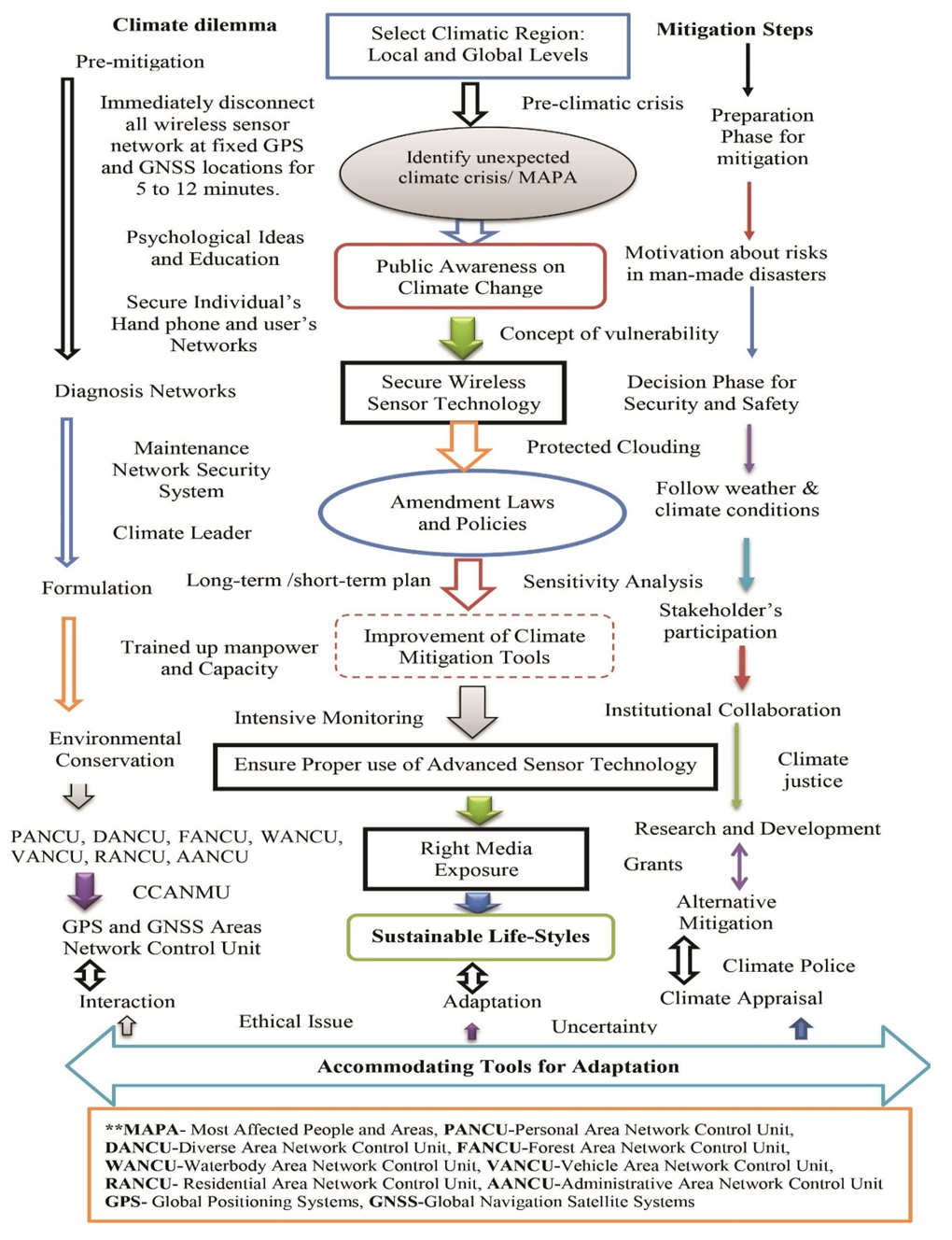 | Figure 32. Mitigation and Adaptation Model from Climate Crisis |
4.3. Challenges
- Increasing social, advanced sensor technological and environmental vulnerabilities for extreme climate events, and the inherent rise of environmental, technological and social problems have made climate change adaptation as an urgent challenge for decision makers [41,59,65,66]. The security challenges are among the several particulars the government and technology experts have decided addressing climate crisis both at home and as a core section of national security and foreign policy [10]. Policy and technological efforts made today and in next-term will affect estimates of people moving due to climate related factors [38,67,68]. Besides, Tens of millions of people are likely to be displaced over the next two to three decades due in huge measure to climate change impacts [10,69]. Moreover, the physical effects will upsurge the potential for uncertainty and conceivably internal conflicts on diplomatic, sensor technological, economic, ethical, humanitarian and defense resources in different countries of the world.
5. Conclusions
- Lastly, the study concludes with the man-made disasters are hurricanes, wildfires, sudden rainfalls, non-seasonal floods, landslide, artificial earthquakes, sensor tsunami, bridge collapsing, river erosion, building damage, tree fell-down, human-beings and animals’ sick, road undulation, object burning, sudden fluctuate temperature, swelling-shrinkage waterbody, droughts, digital poisoning and killing. Many of the world's scientists, researchers, experts and statesmen are worried, surprised and shocked by the unexpected climate change. They are all looking for the right way to live well for present and future generations. Climate and environmental experts are exploring ways to address climate change in a variety of ways, such as research, policy development, opinion, public meetings, awareness, conferences, seminars, summits and roundtable dialogues. To date, no one has been able to find the right solution to the climate crisis, but some people are talking nonsense and misleading the public with misinformation. They are spreading misinterpretation in the media, although they do not have the right idea about it. Anyone who knows the right way to do this is being hypnotized by cyber hackers through sensor geofencing. Many scientists are being crippled by sensor diseases. Someone is being killed or paralyzed. Again, many do not understand the main secret of unexpected effect. Because sophisticated sensor technology has given people mobility, again it has embraced the stagnation of life. That is why some people have brought enthusiasm for success, while others have increased frustration. As cyber hackers have done, the spread of Corona disease worldwide and its effects. Similarly, cyber hackers are misusing sensor technology to cause climate change around the world. The researchers believe that the publication of this study will open the eyes of all in the conscious community, and they will understand - the main cause of global climate change.
6. Declaration
- FundingThis research work is a part of PhD Thesis, which was funded by the Zamalah Postgraduate Scholarship of UNIMAS, Malaysia and also sponsored by the Information and Communication Technology Division, Ministry of Posts, Telecommunications and Information Technology, Government of People’s Republic of Bangladesh. The funders had no role in the design of the research, in data collection, analyses or final interpretation of data, in the writings of the manuscript, or in the decision to publish the findings.Data AvailabilityThe data being used to support the findings of this research work are available from the corresponding author upon request. Competing InterestsThe authors declare no potential conflict of interests in this research work.
ACKNOWLEDGEMENTS
- The authors acknowledged the authority of Universiti of Malaysia Sarawak (UNIMAS), Malaysia for providing the Zamalah Postgraduate Scholarship for the completion of PhD degree. The authors are also grateful to the authority of the Information and Communication Technology Division, Ministry of Posts, Telecommunications and Information Technology, Government of People’s Republic of Bangladesh, for PhD Fellowship during the higher study in Malaysia. The authors acknowledged the authority of North East Medical College & Hospital (NEMCH), affiliated with Sylhet Medical University at Sylhet in Bangladesh for kind support. The authors also acknowledged the higher authority of International Conference on Innovation and Transformation for Development (ITD-2021) at Green University of Bangladesh, Dhaka, Bangladesh for oral presentation.
 Abstract
Abstract Reference
Reference Full-Text PDF
Full-Text PDF Full-text HTML
Full-text HTML